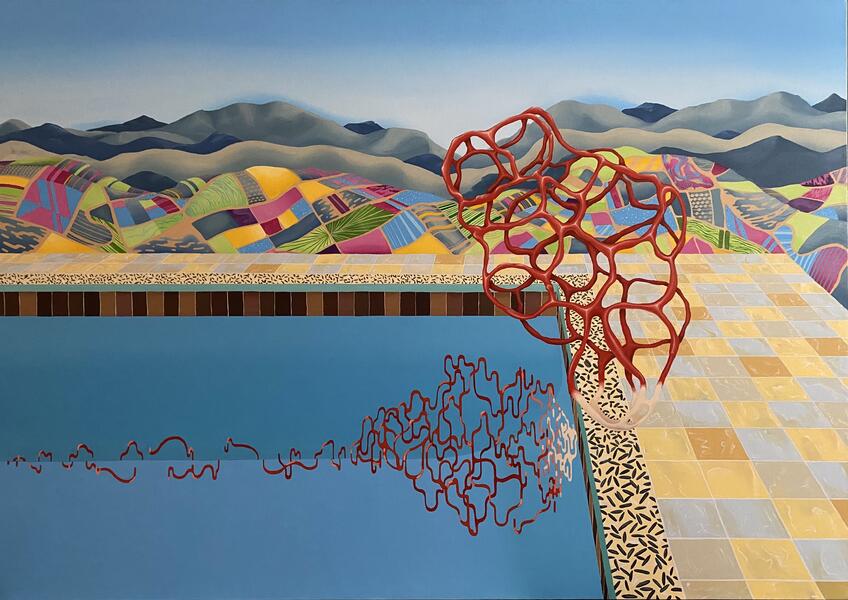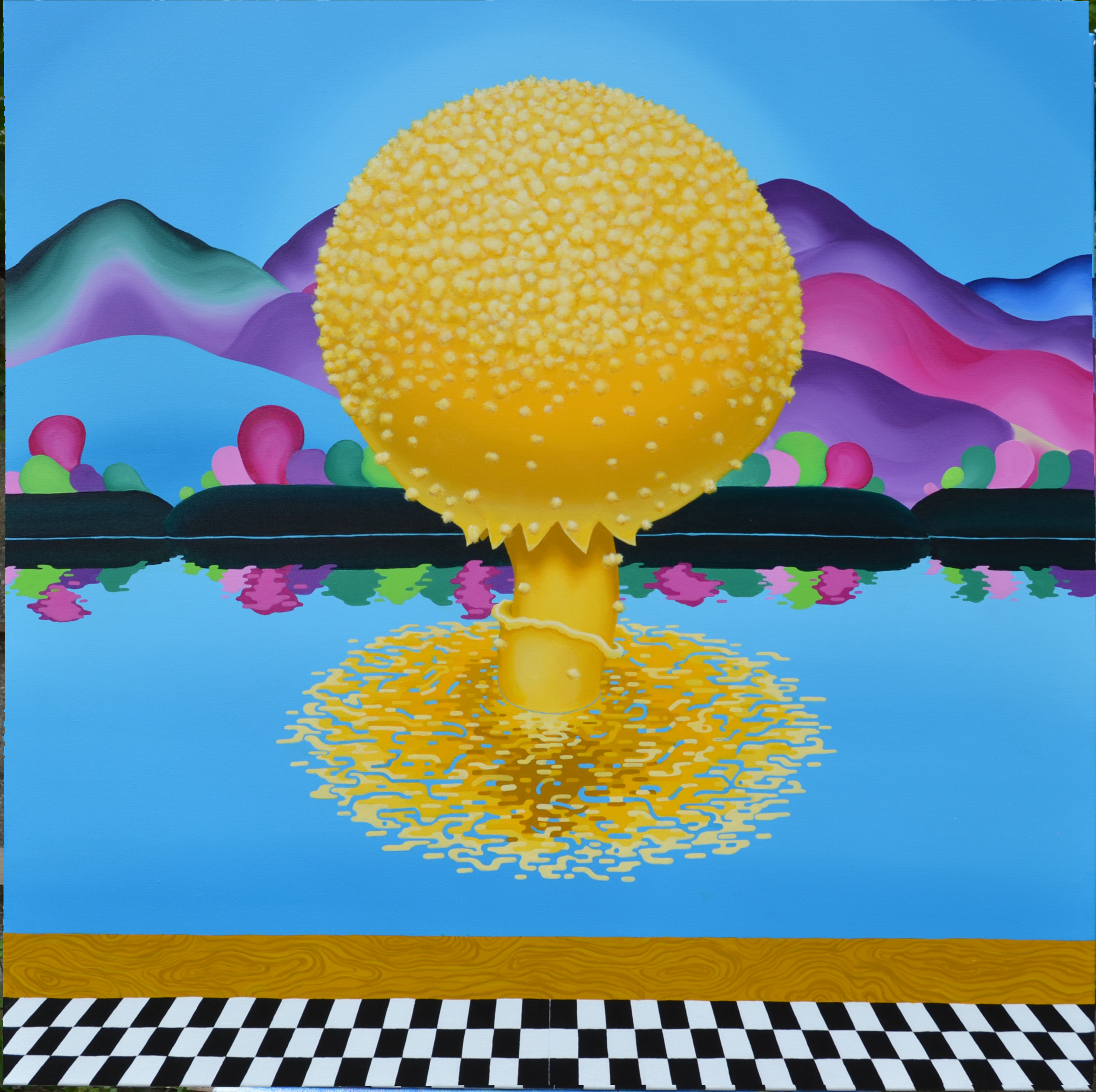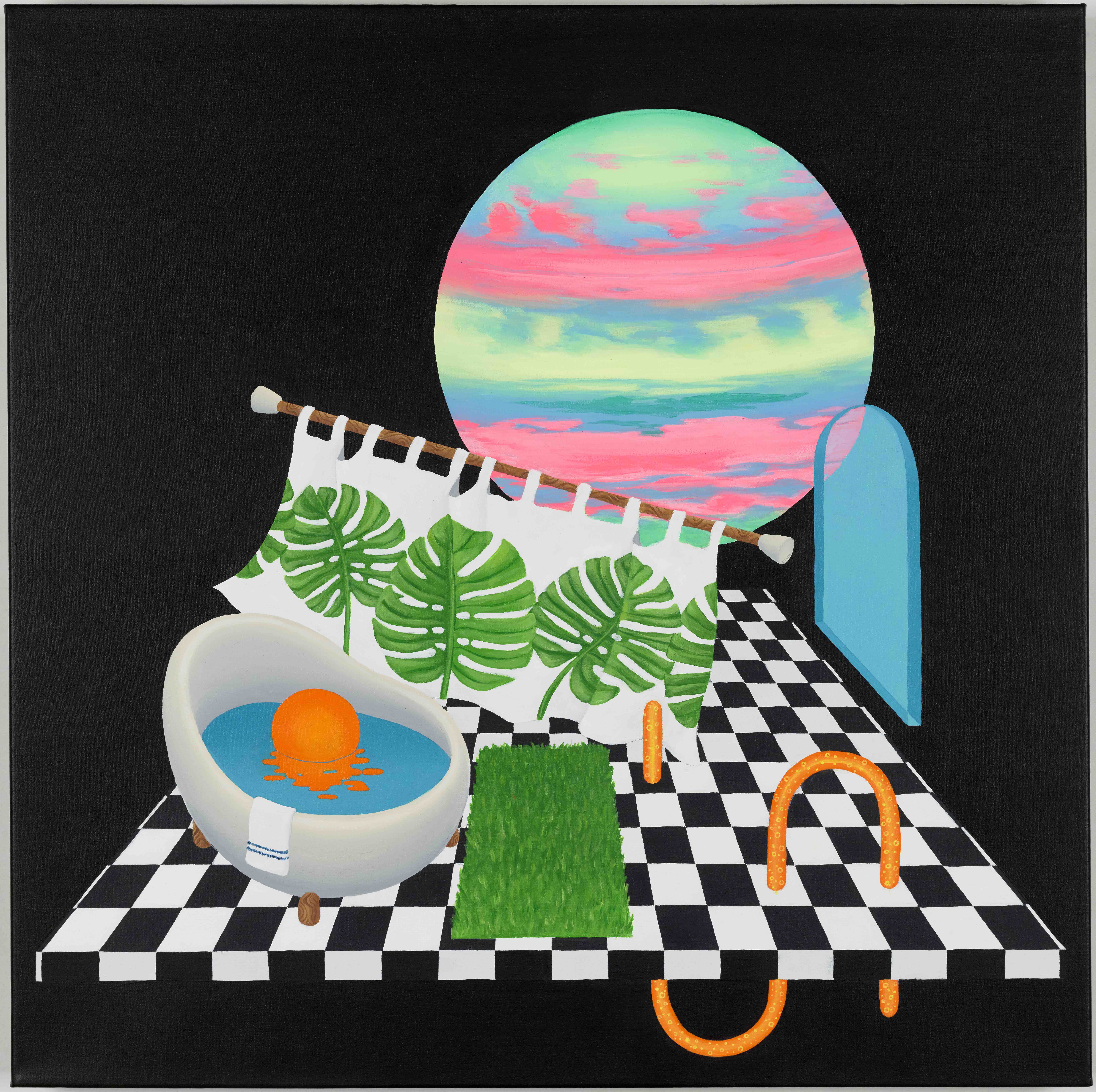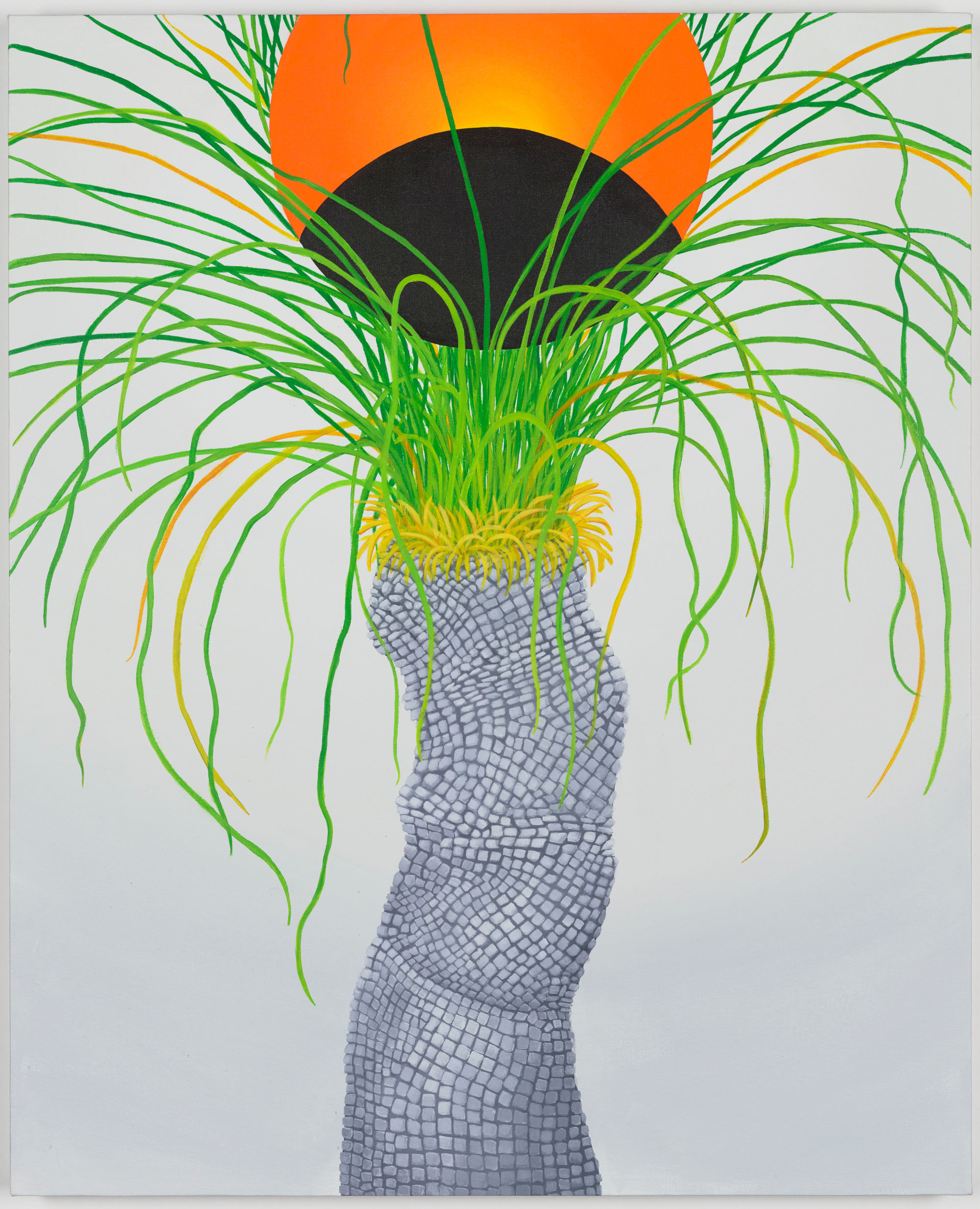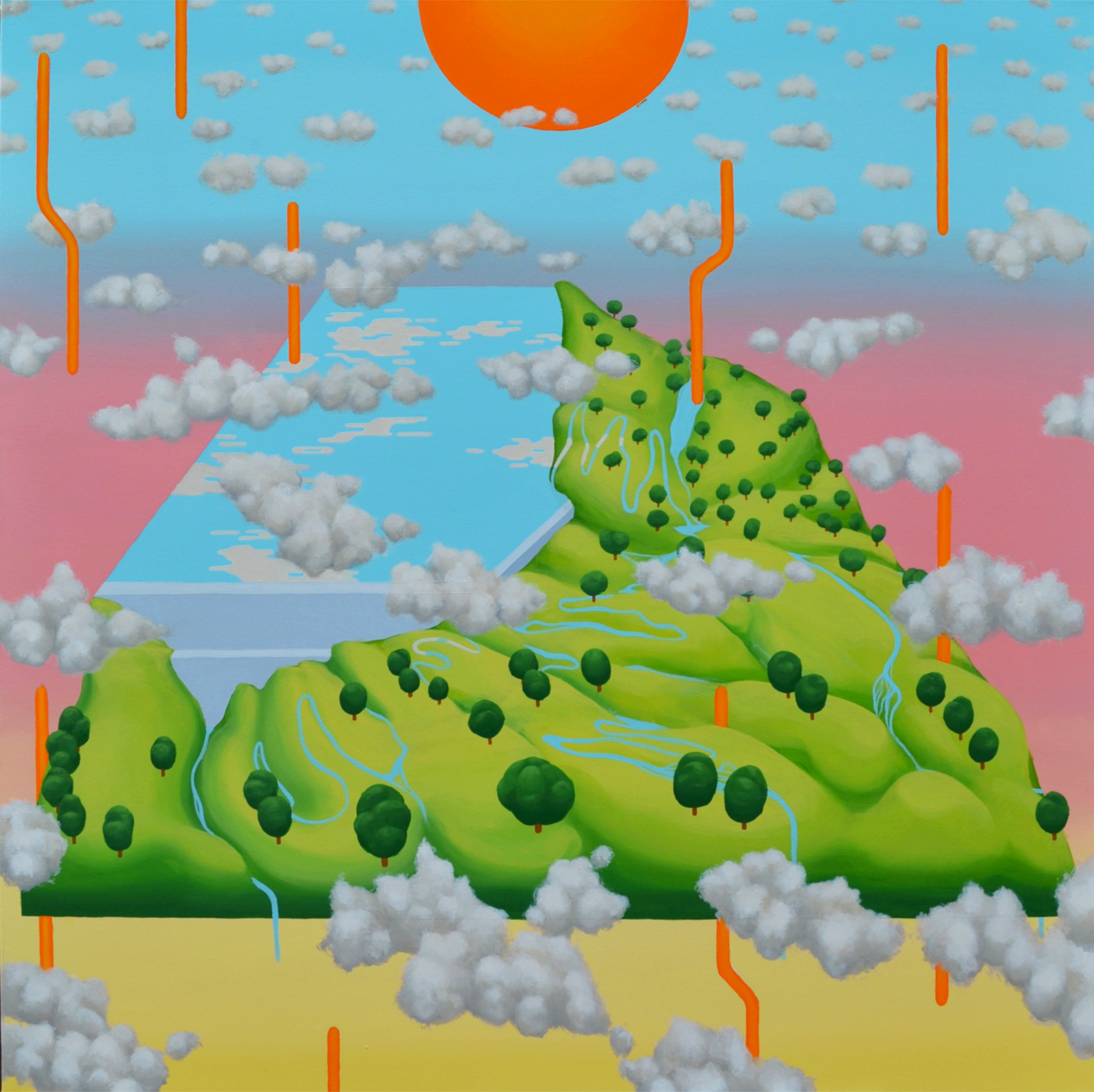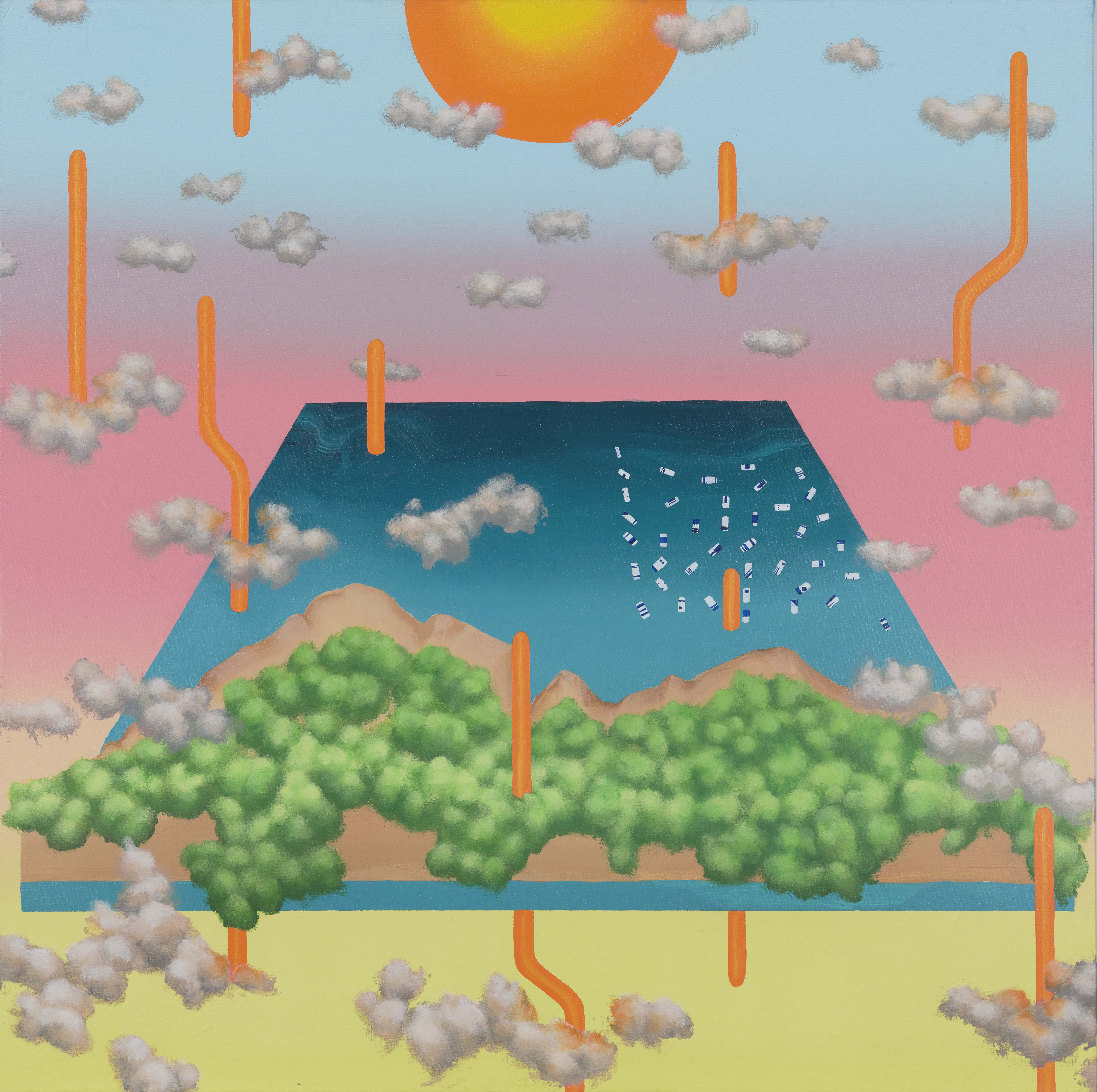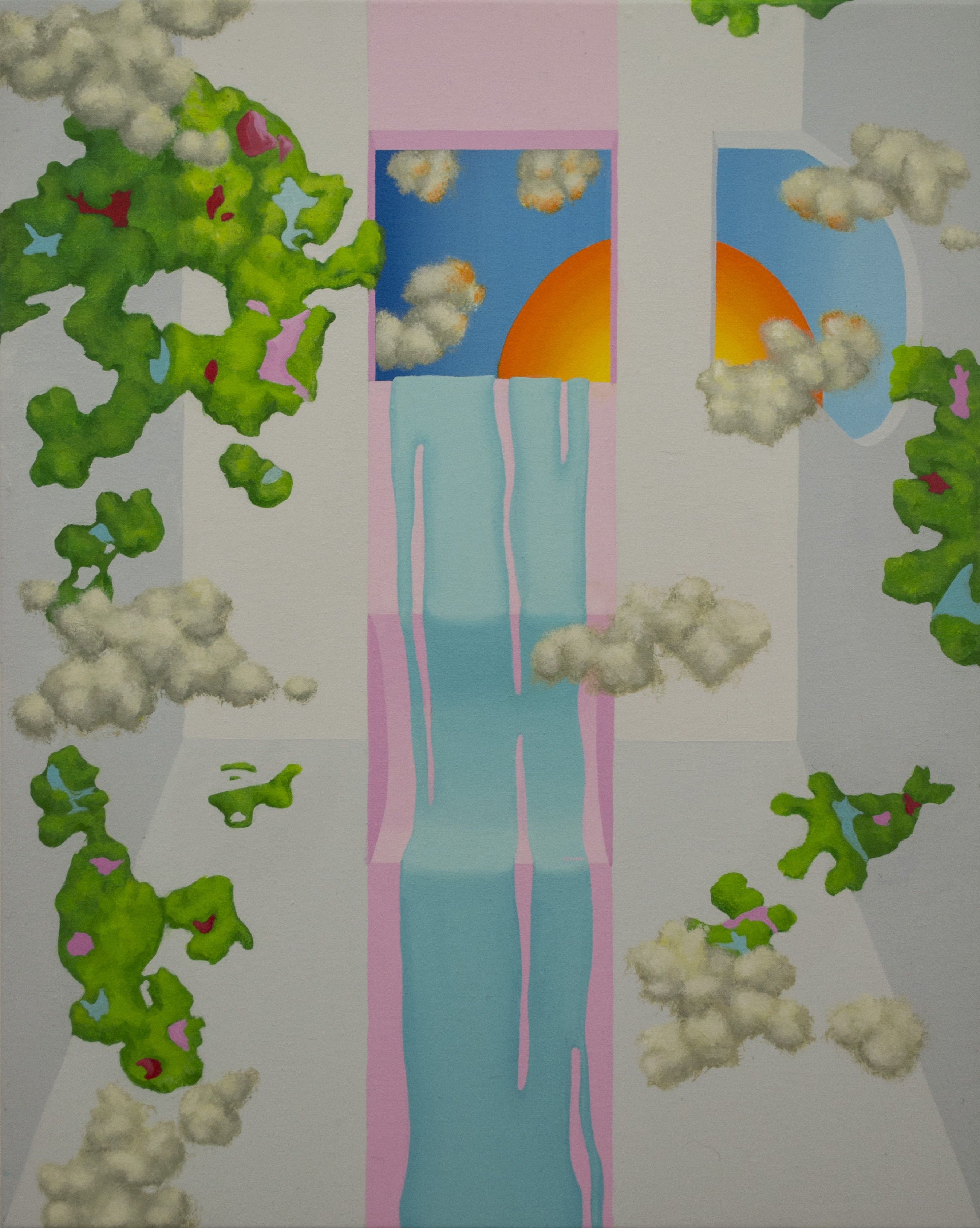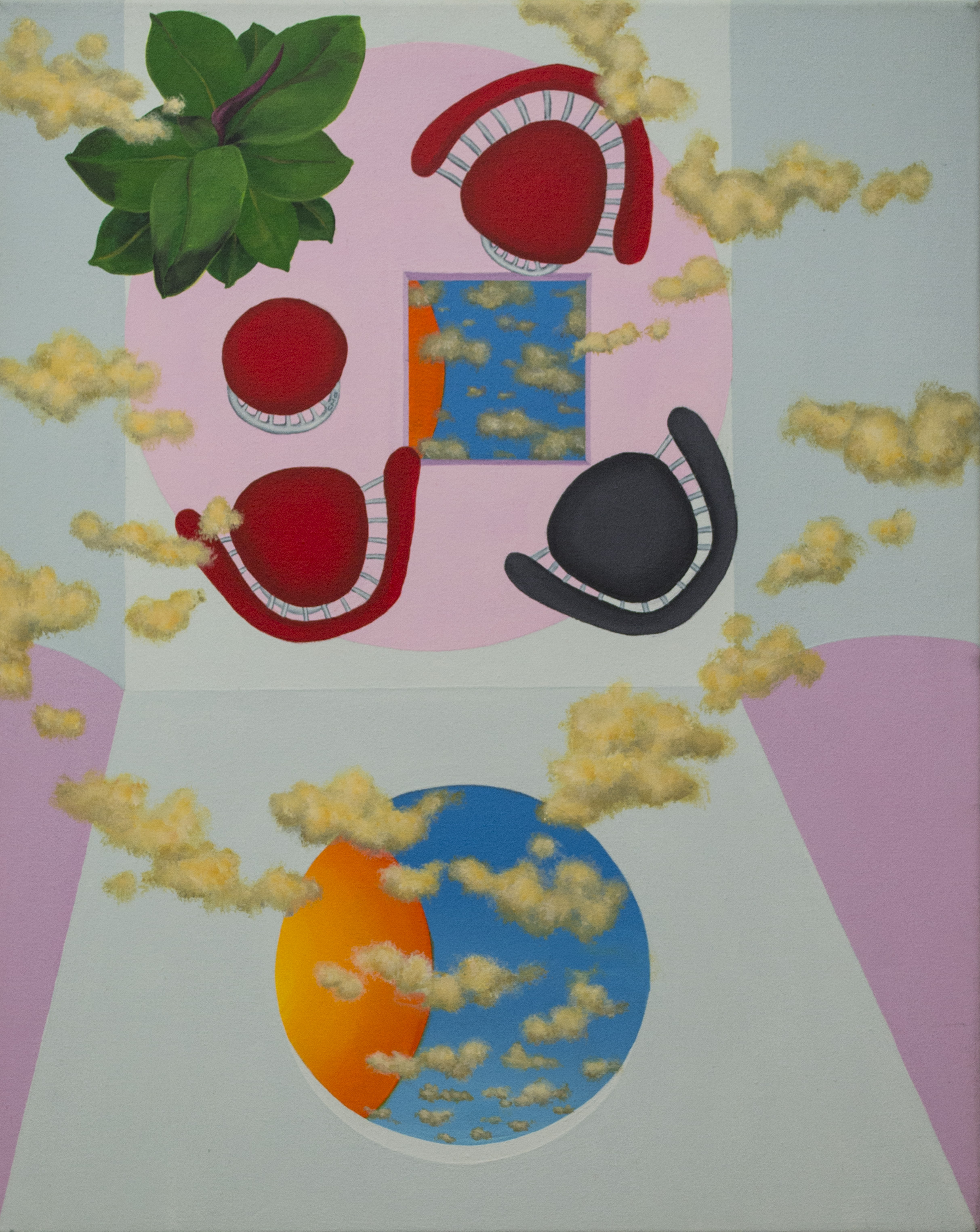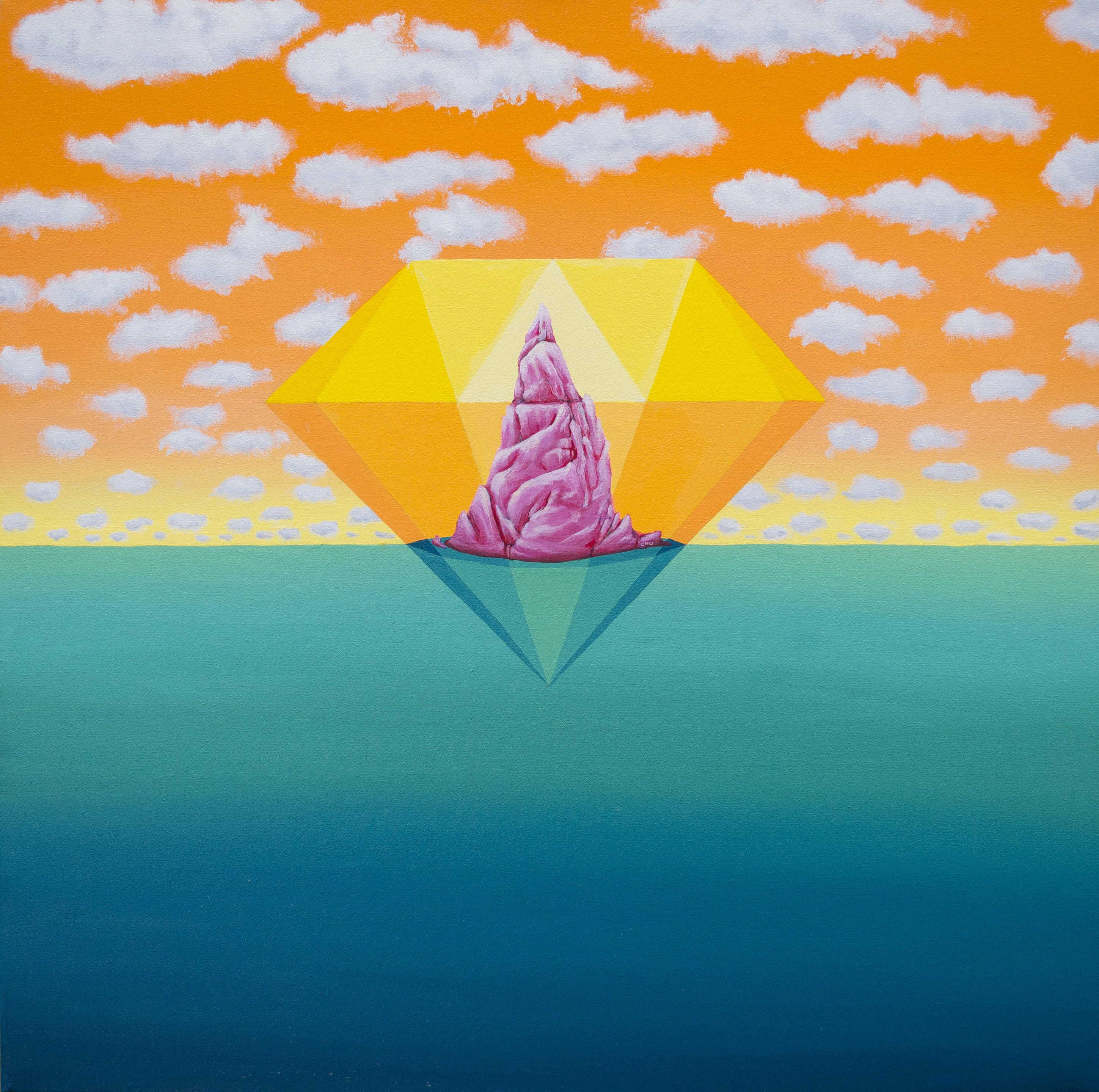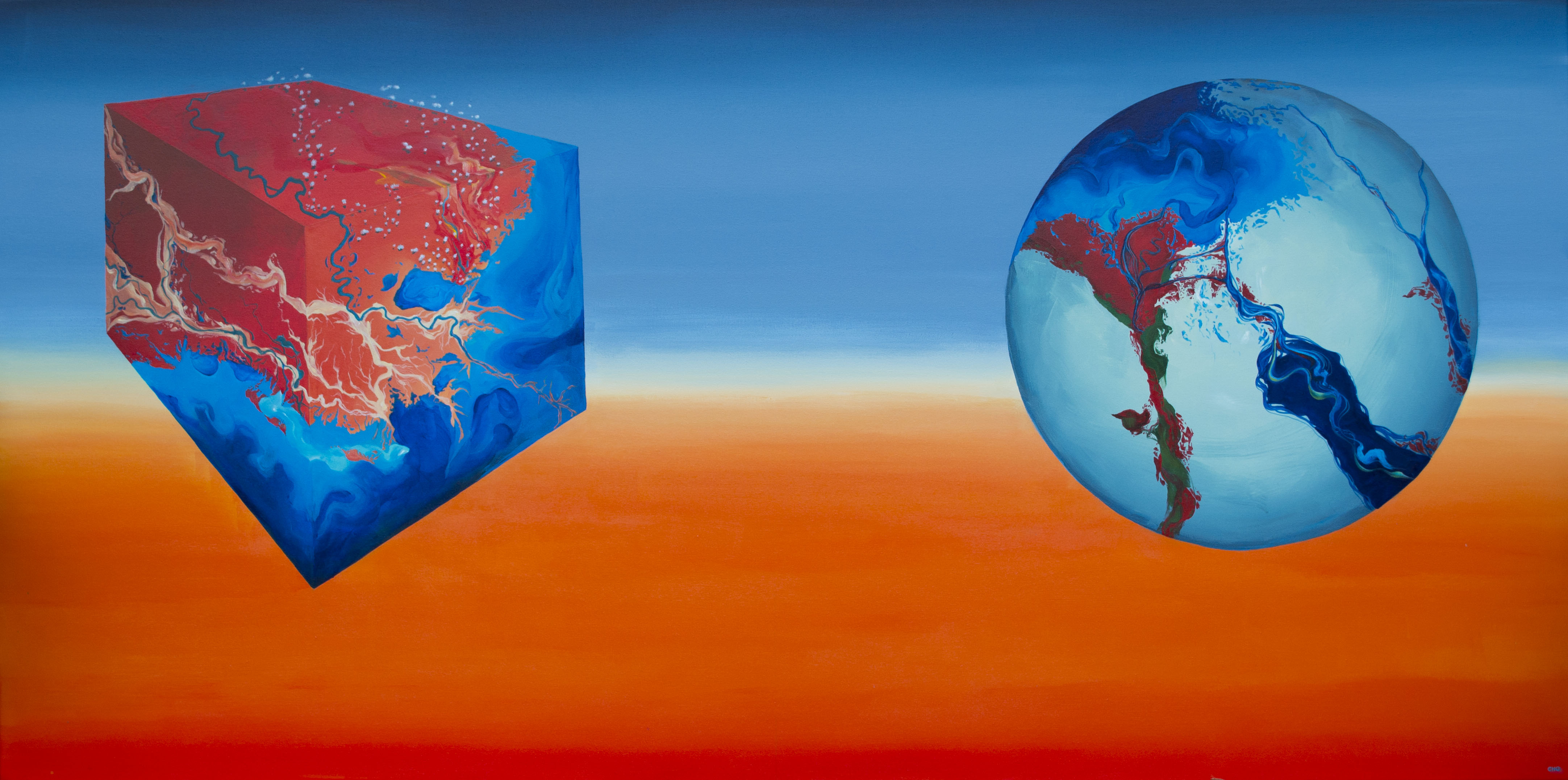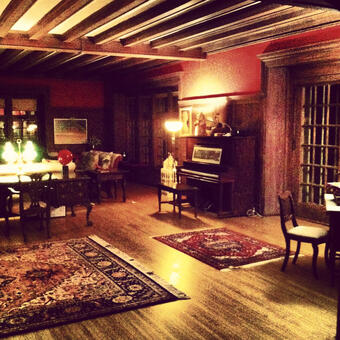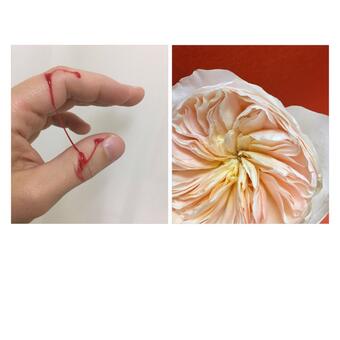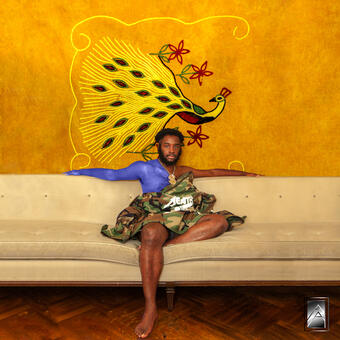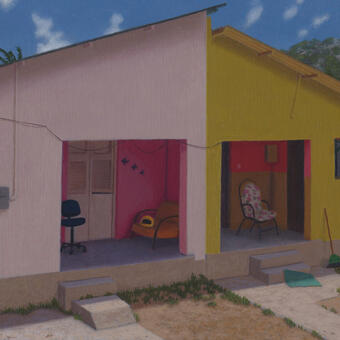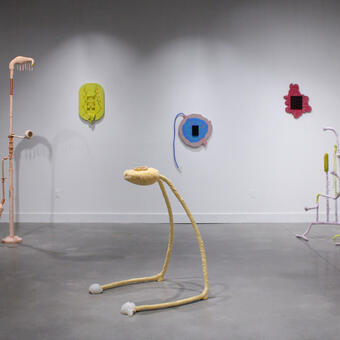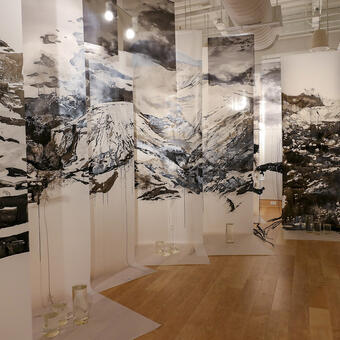Work samples
-
 Blood Clock 2020 May.jpegThe Blood Clock 2020 series of paintings are my response to Pipilotti Rist’s Blood Clip (1993) that displays copious flows of menstrual blood, for which she was accused of taking feminism too far. What does it mean to take feminism too far? This criticism of Rist’s work presented an interesting challenge to me. How do we rebel against social taboo and biological reductionism in favor of inclusive narrative about our bodies and biology? Menstrual taboo and stereotypes are ingrained in both historical and contemporary social structures and encompasses religion, politics, economics, ethnicity, class, gender identity, and other sociocultural factors. I chronicle the days of each month of the year 2020 when our collective sense of time had been distorted by the global pandemic. I integrated imagery from Georgia O’Keefe, who masterfully painted flower/vaginal images without stirring any sense of embarrassment or perverting the subject, to have an open conversation around menstruation, blood, and reproduction.
Blood Clock 2020 May.jpegThe Blood Clock 2020 series of paintings are my response to Pipilotti Rist’s Blood Clip (1993) that displays copious flows of menstrual blood, for which she was accused of taking feminism too far. What does it mean to take feminism too far? This criticism of Rist’s work presented an interesting challenge to me. How do we rebel against social taboo and biological reductionism in favor of inclusive narrative about our bodies and biology? Menstrual taboo and stereotypes are ingrained in both historical and contemporary social structures and encompasses religion, politics, economics, ethnicity, class, gender identity, and other sociocultural factors. I chronicle the days of each month of the year 2020 when our collective sense of time had been distorted by the global pandemic. I integrated imagery from Georgia O’Keefe, who masterfully painted flower/vaginal images without stirring any sense of embarrassment or perverting the subject, to have an open conversation around menstruation, blood, and reproduction. -
 Pluto.jpgThe image of modular living spaces against solar objects materialized in full color in my mind when I read about India Mahdavi’s global approach to interior design. She said, “I see space being divided by curtains instead of having walls. Because it gives you the modularity.” I was inspired by her use of colors, textures, and shapes to create livingscapes that are both otherworldly and familiar. Painting the human spaces alongside the solar objects felt like creating miniatures, a subject matter to which Gaston Bachelard dedicated an entire chapter in The Poetics of Space, examining how they shape the imagining being through fantasy and daydreaming. In it, he stated: “One must go beyond logic in order to experience what is large in what is small.” I wanted to explore this space beyond logic. The lush images of planets, dwarf planets, and moons provided a creative foundation for exploring various elements to create my own dreamscapes. Painting this series brought me back a fond childhood memory of building Lego houses and spaceships, of making my own rules and improvising, of taking joy in things that are cute, funny, and mind-blowing.
Pluto.jpgThe image of modular living spaces against solar objects materialized in full color in my mind when I read about India Mahdavi’s global approach to interior design. She said, “I see space being divided by curtains instead of having walls. Because it gives you the modularity.” I was inspired by her use of colors, textures, and shapes to create livingscapes that are both otherworldly and familiar. Painting the human spaces alongside the solar objects felt like creating miniatures, a subject matter to which Gaston Bachelard dedicated an entire chapter in The Poetics of Space, examining how they shape the imagining being through fantasy and daydreaming. In it, he stated: “One must go beyond logic in order to experience what is large in what is small.” I wanted to explore this space beyond logic. The lush images of planets, dwarf planets, and moons provided a creative foundation for exploring various elements to create my own dreamscapes. Painting this series brought me back a fond childhood memory of building Lego houses and spaceships, of making my own rules and improvising, of taking joy in things that are cute, funny, and mind-blowing. -
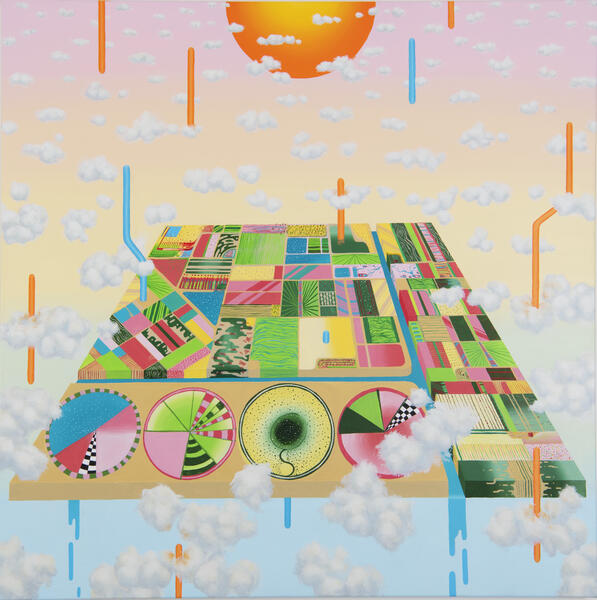 FC_Ag_land.jpgThe paintings of Extraction are created in the intersection of landscape and abstraction. I sought the freedom of expression through automatic movements of my hands, rather than trying to exact the slice of nature’s chaos. I imagined what Georgia O’Keeffe saw in the air, a landscape that transforms into a tapestry of colors in abstraction . The paintings of Extraction attempt to capture this blurring of boundaries and scales. At the same time, the paintings of Extraction are created through a negotiation of creative desire and scientific inquiry into the extractive human existence on Earth.
FC_Ag_land.jpgThe paintings of Extraction are created in the intersection of landscape and abstraction. I sought the freedom of expression through automatic movements of my hands, rather than trying to exact the slice of nature’s chaos. I imagined what Georgia O’Keeffe saw in the air, a landscape that transforms into a tapestry of colors in abstraction . The paintings of Extraction attempt to capture this blurring of boundaries and scales. At the same time, the paintings of Extraction are created through a negotiation of creative desire and scientific inquiry into the extractive human existence on Earth. -
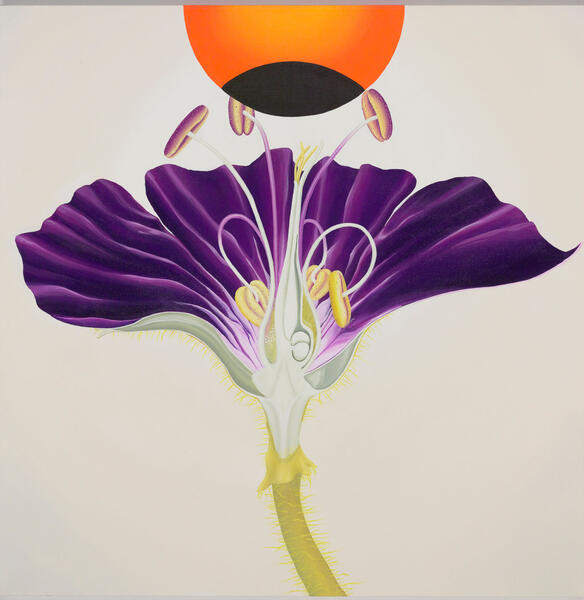 balckwidow.jpgIn these paintings, I wanted to convert the reality I observed in the solar composition, responsible for the eclipse, into a creative process. It was simple at first with some walls and floors hosting the eclipse, then different contexts emerged as the series expanded. The series includes suns eclipsing in grey, synthetic, and natural structures and suns eclipsing in plants, along with two light box paintings staging the sun.
balckwidow.jpgIn these paintings, I wanted to convert the reality I observed in the solar composition, responsible for the eclipse, into a creative process. It was simple at first with some walls and floors hosting the eclipse, then different contexts emerged as the series expanded. The series includes suns eclipsing in grey, synthetic, and natural structures and suns eclipsing in plants, along with two light box paintings staging the sun.
About Se Jong
Se Jong (Born in Seoul, South Korea, 1978) makes art to explore the extent of her imagination and broaden her creative domain. She began painting while pursuing her PhD in Environmental Engineering. Her training as a scientist taught her to become observant and think critically, and she cultivated her brand of creative expression that combine multidisciplinary perspectives and approaches.
Mushrooms and Mycelia
Mushrooms and mycelia demonstrate reciprocal arrangements among different species as an integral element of evolution and survival in nature. They provide clues to unravel the dualism that sets humanity and nature at opposite poles. Science and art can help to gain a broader and more comprehensive understanding of the natural world in order for us to rethink wilderness and to imagine more reciprocal relations. These paintings are my reflection of the microorganisms that can teach us about living symbiotically in nature.
Blood Clock 2020
-
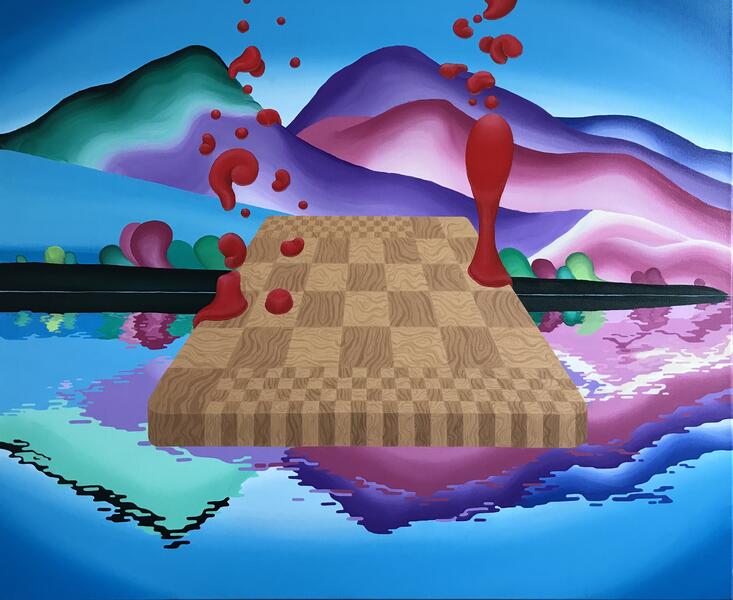 Blood Clock 2020: MayAcrylic on canvas 30”x36” 2022
Blood Clock 2020: MayAcrylic on canvas 30”x36” 2022 -
 Blood Clock 2020: AugustAcrylic on canvas 30”x36” 2022
Blood Clock 2020: AugustAcrylic on canvas 30”x36” 2022 -
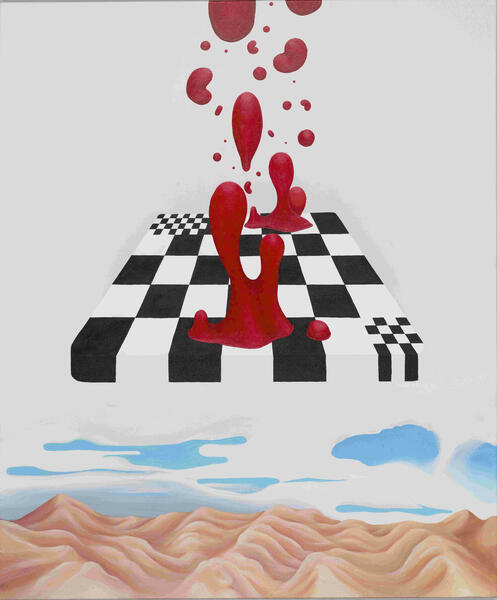 Blood Clock 2020: JanuaryAcrylic on Canvas 30”x36” 2021
Blood Clock 2020: JanuaryAcrylic on Canvas 30”x36” 2021 -
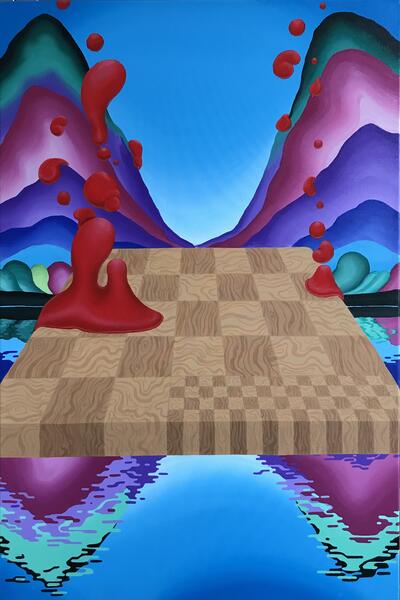 Blood Clock 2020: JuneAcrylic on canvas 30”x24” 2022
Blood Clock 2020: JuneAcrylic on canvas 30”x24” 2022 -
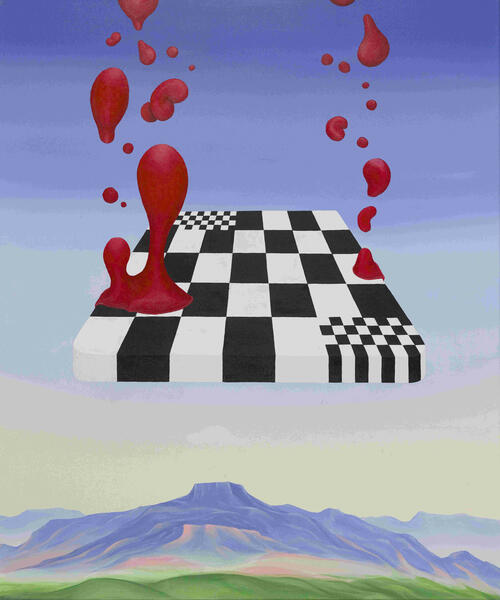 Blood Clock 2020: AprilAcrylic on Canvas 30”x36” October 28, 2018
Blood Clock 2020: AprilAcrylic on Canvas 30”x36” October 28, 2018 -
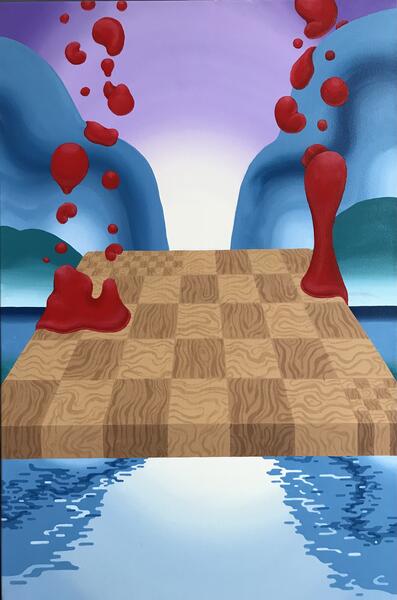 Blood Clock 2020: JulyAcrylic on canvas 30”x24” 2022
Blood Clock 2020: JulyAcrylic on canvas 30”x24” 2022 -
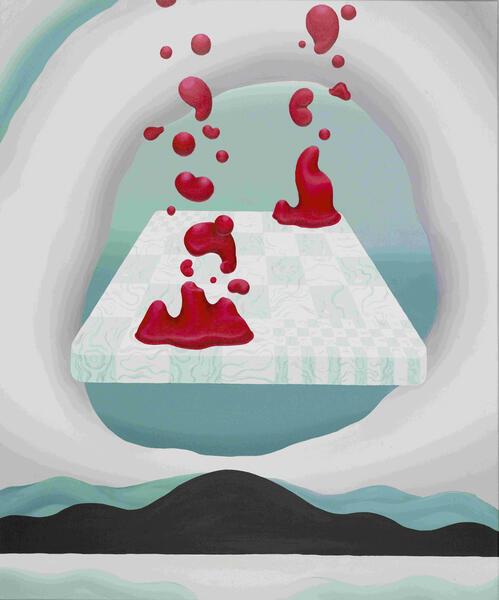 Blood Clock 2020: SeptemberAcrylic on Canvas 36”x30” October 28, 2018
Blood Clock 2020: SeptemberAcrylic on Canvas 36”x30” October 28, 2018 -
 Blood Clock 2020: DecemberAcrylic on canvas 30”x36” 2022
Blood Clock 2020: DecemberAcrylic on canvas 30”x36” 2022 -
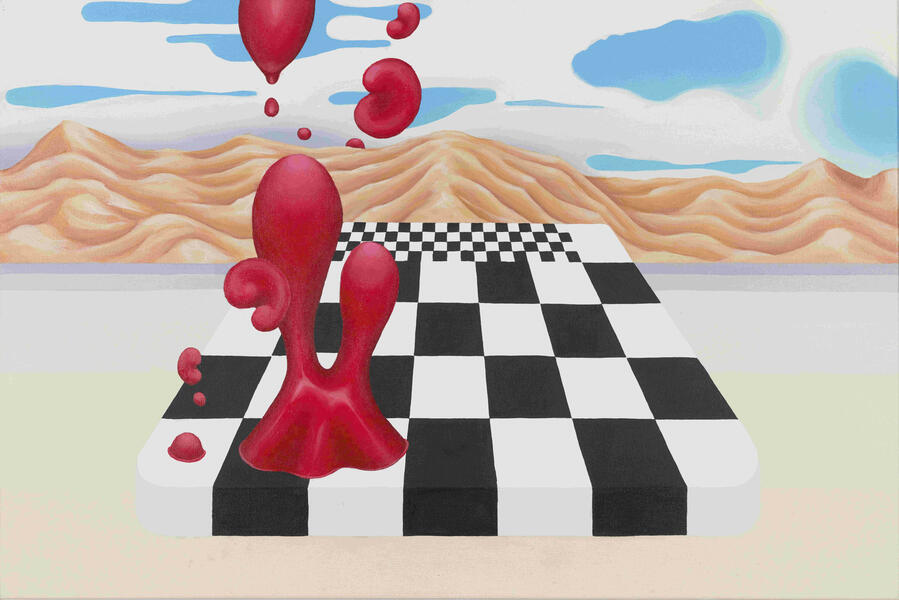 Blood Clock 2020: FebruaryAcrylic on Canvas 36”x30” 2022
Blood Clock 2020: FebruaryAcrylic on Canvas 36”x30” 2022 -
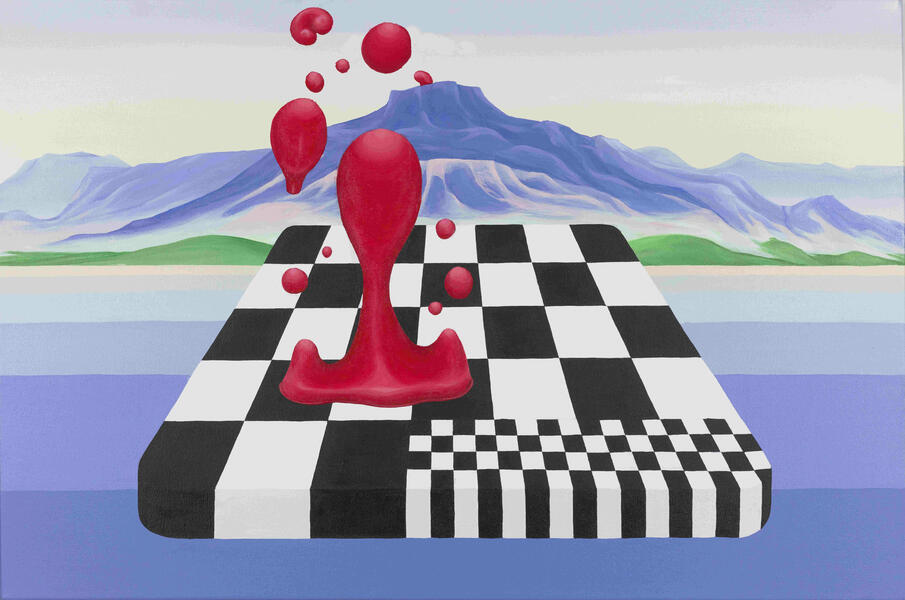 Blood Clock 2020: MarchAcrylic on Canvas 36”x36” 2022
Blood Clock 2020: MarchAcrylic on Canvas 36”x36” 2022
Modularity Space
Painting the human spaces alongside the solar objects felt like creating miniatures, a subject matter to which Gaston Bachelard dedicated an entire chapter in The Poetics of Space, examining how they shape the imagining being through fantasy and daydreaming. In it, he stated: “One must go beyond logic in order to experience what is large in what is small.” I wanted to explore this space beyond logic. The lush images of planets, dwarf planets, and moons provided a creative foundation for exploring various elements to create my own dreamscapes. Painting this series brought me back a fond childhood memory of building Lego houses and spaceships, of making my own rules and improvising, of taking joy in things that are cute, funny, and mind-blowing.
-
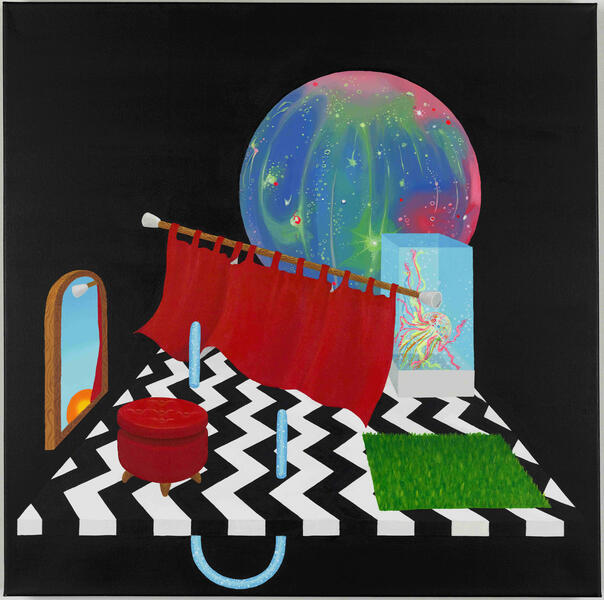 Mercury LoungeAcrylic on canvas 24”x24” 2019
Mercury LoungeAcrylic on canvas 24”x24” 2019 -
 Venus TransitAcrylic on Canvas 24”x24” 2019
Venus TransitAcrylic on Canvas 24”x24” 2019 -
 Earth Reading RoomAcrylic on Canvas 24”x24” 2019
Earth Reading RoomAcrylic on Canvas 24”x24” 2019 -
 Moon BedroomAcrylic on Canvas 24”x24” 2019
Moon BedroomAcrylic on Canvas 24”x24” 2019 -
 Mars StudyAcrylic on Canvas 24”x24” 2019
Mars StudyAcrylic on Canvas 24”x24” 2019 -
 Jupyter BathAcrylic on Canvas 24”x24” 2019
Jupyter BathAcrylic on Canvas 24”x24” 2019 -
 Saturn GalleryAcrylic on Canvas 24”x24” 2019
Saturn GalleryAcrylic on Canvas 24”x24” 2019 -
 Uranus PoolAcrylic on Canvas 24”x24” 2019
Uranus PoolAcrylic on Canvas 24”x24” 2019 -
 Neptune BreezeAcrylic on Canvas 24”x24” 2019
Neptune BreezeAcrylic on Canvas 24”x24” 2019 -
 Titan SpaAcrylic on Canvas 24”x24” 2019
Titan SpaAcrylic on Canvas 24”x24” 2019
Backgrounds
-
 Background 6Watercolor on paper 4"x6" 2022
Background 6Watercolor on paper 4"x6" 2022 -
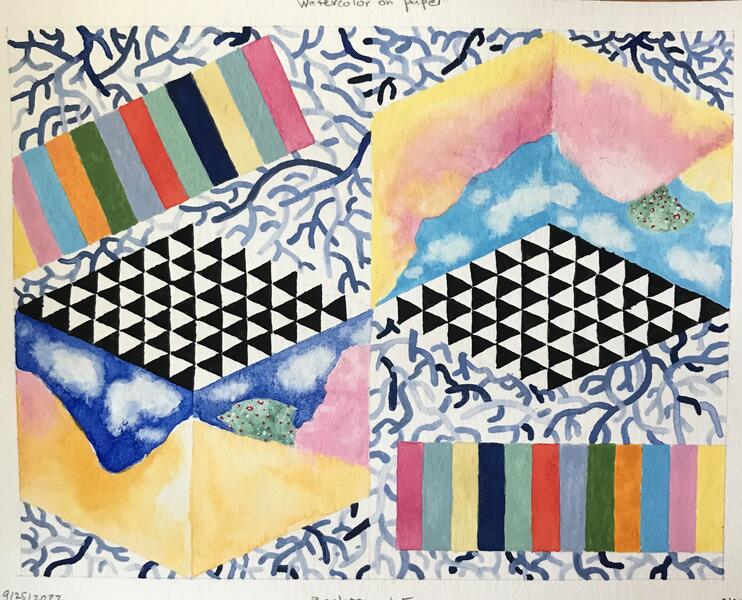 Background 5Watercolor on paper 4"x6" 2022
Background 5Watercolor on paper 4"x6" 2022 -
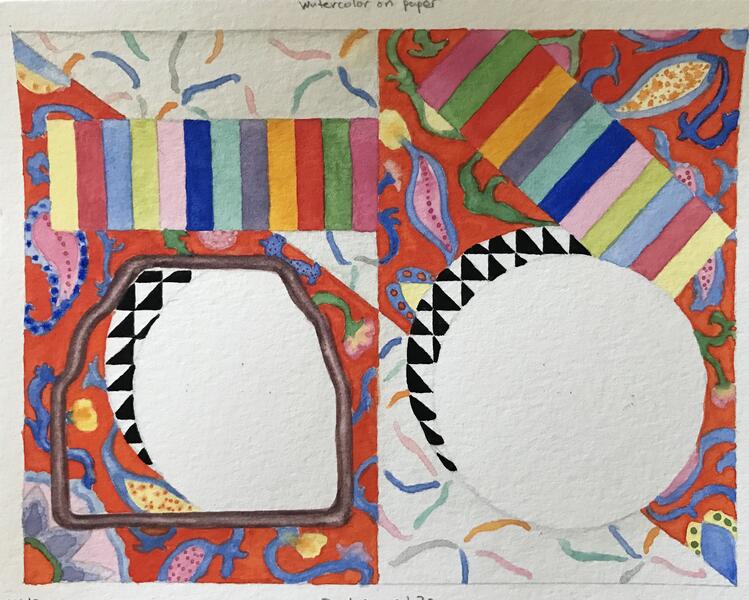 Background 3aWatercolor on paper 4"x6" 2022
Background 3aWatercolor on paper 4"x6" 2022 -
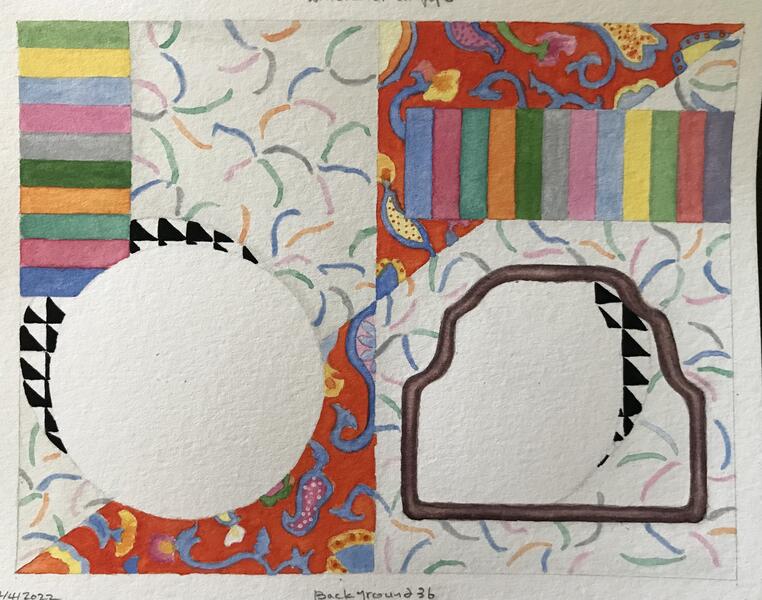 Background 3bWatercolor on paper 4"x6" 2022
Background 3bWatercolor on paper 4"x6" 2022 -
 Background 4Watercolor on paper 4"x6" 2022
Background 4Watercolor on paper 4"x6" 2022 -
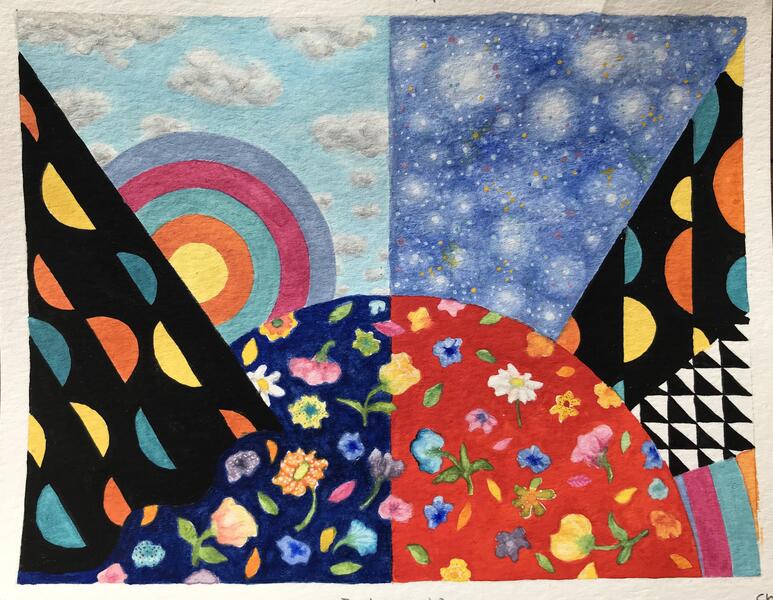 Background 2Watercolor on paper 4"x6" 2022
Background 2Watercolor on paper 4"x6" 2022 -
 Background 1Watercolor on paper 4"x6" 2022
Background 1Watercolor on paper 4"x6" 2022 -
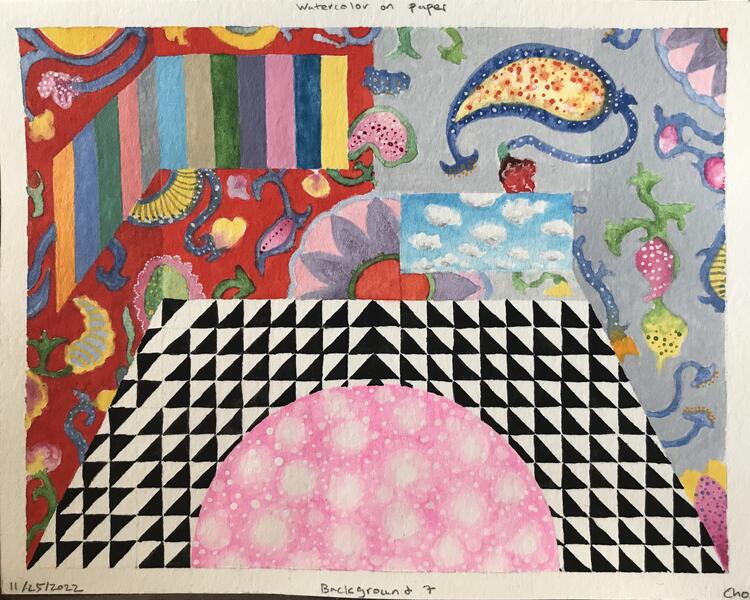 Background 7Watercolor on paper 4"x6" 2022
Background 7Watercolor on paper 4"x6" 2022 -
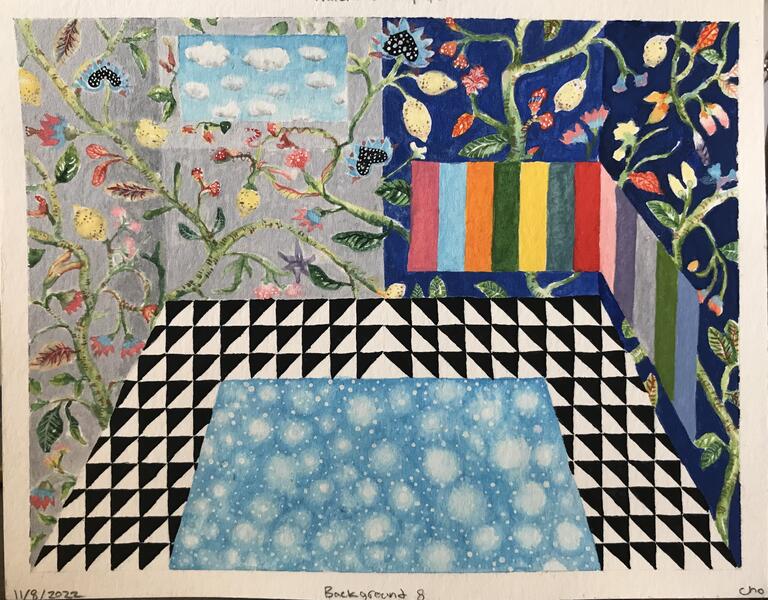 Background 8Watercolor on paper 4"x6" 2022
Background 8Watercolor on paper 4"x6" 2022 -
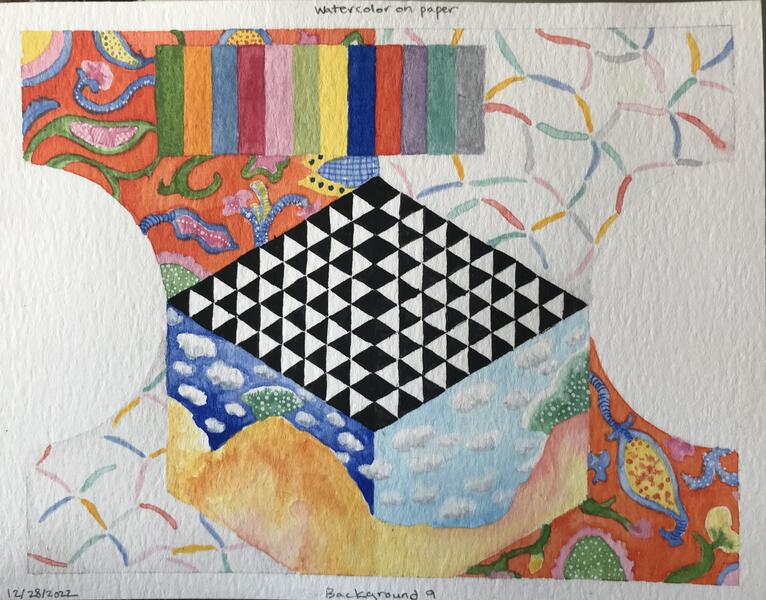 Background 9Watercolor on paper 4"x6" 2022
Background 9Watercolor on paper 4"x6" 2022
Eclipse: Infinite Ending
James Baldwin declared that he is an observer. Observers, like Baldwin, are important members of our society; they remember, record, and reflect our realities, our past and present conditions, and our dreams for the future. I strive to become a keen observer. As a scientist, I am trained to observe and interpret the physical world. I grapple with natural processes and the uncertainties bound to the randomness that is intrinsic to nature. My scientific training influences how I approach painting and defines my identity as an artist (and as an observer). Thus, I find myself in a unique position, from pursuing multiple disciplines, to expose nature’s deceptions resulting from the limits of our perception.
In these paintings, I wanted to convert the reality I observed in the solar composition, responsible for the eclipse, into a creative process. It was simple at first with some walls and floors hosting the eclipse, then different contexts emerged as the series expanded. The series includes suns eclipsing in grey, synthetic, and natural structures and suns eclipsing in plants, along with two light box paintings staging the sun.
I took some hints from Hilma af Klint whose stint as a scientific illustrator seemed to have planted a seed for her magical abstractions. I was drawn to scientific and botanical art because they make knowledge and discoveries accessible. These paintings are inspired by both traditional botanical art (e.g., Franz Bauer’s illustration of Bird of paradise (c.1818)) and innovations made in high-resolution photography (e.g., Andrew Syred’s scanning electron microscope (SEM) image of Forget-me-not flower (2007)).
I also present two sets of watercolor paintings of butterflies and moths. They are inspired by Nabokov who saw colors for different letters of the alphabet and collected butterflies like he hunted for perfect elegant words. He was a master of deception creating many prodigiously sophisticated illusions, because he understood nature always deceives.
-
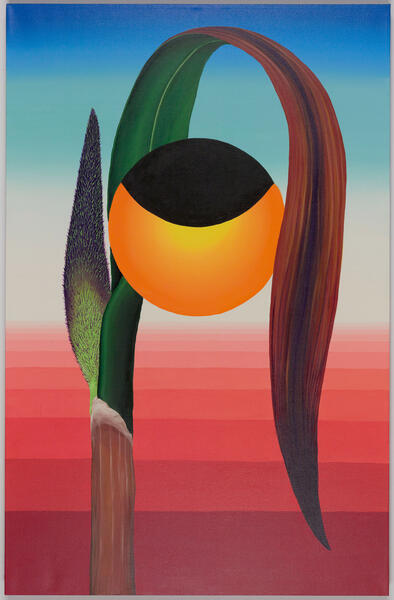 Purple Majesty40”x26” Acrylic on Canvas 2020
Purple Majesty40”x26” Acrylic on Canvas 2020 -
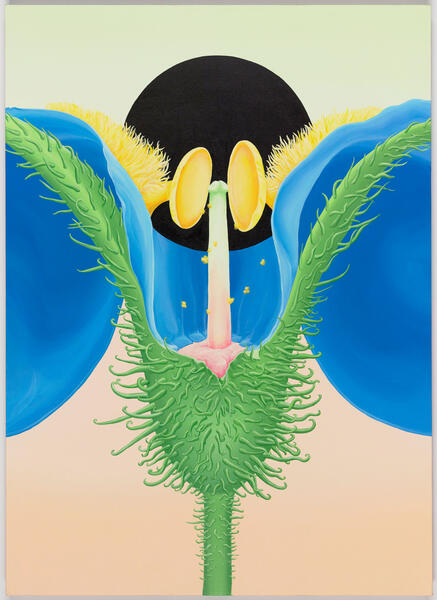 Forget Me Not36”x26” Acrylic on Canvas 2020
Forget Me Not36”x26” Acrylic on Canvas 2020 -
 Grass Tree36”x26” Acrylic on Canvas 2020
Grass Tree36”x26” Acrylic on Canvas 2020 -
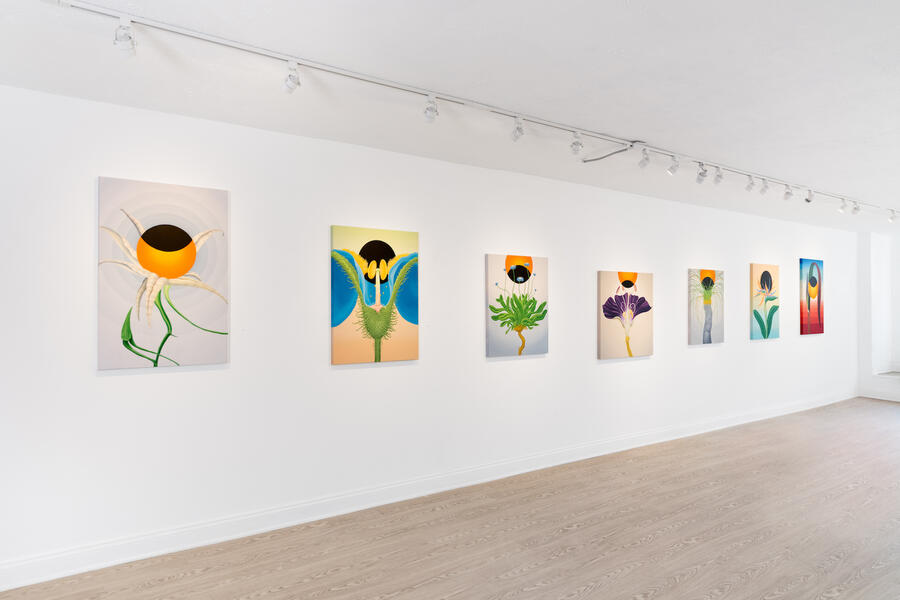 Catalyst installationInstallation view
Catalyst installationInstallation view -
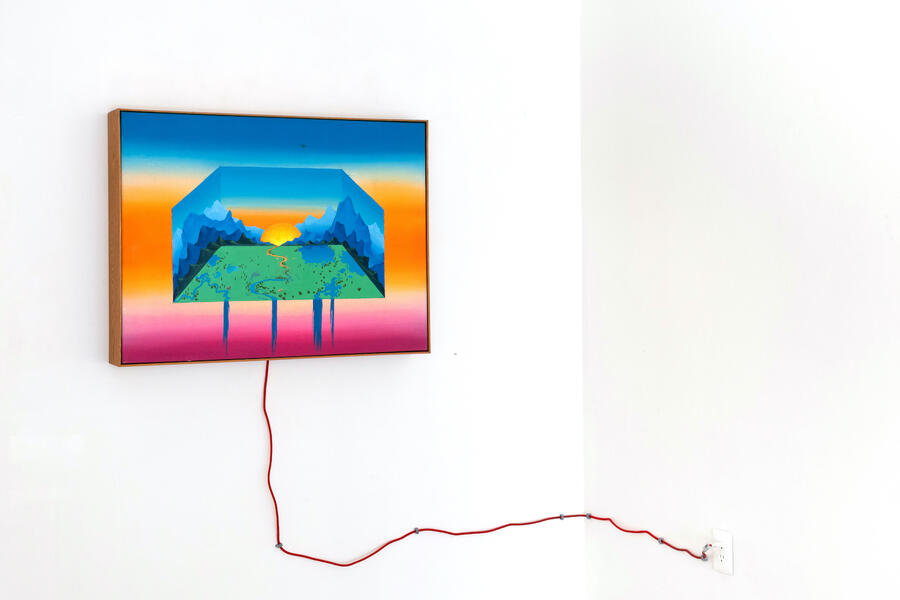 Catalyst installation2Installation view
Catalyst installation2Installation view -
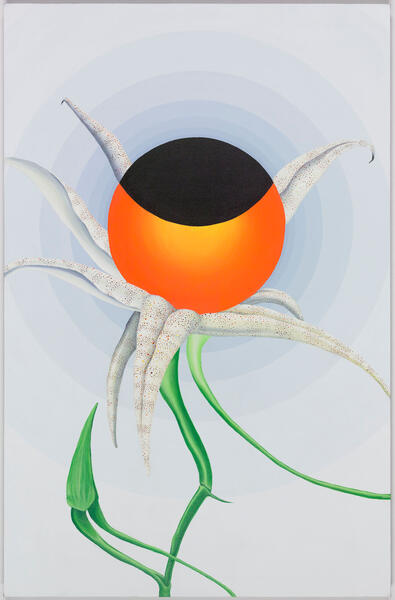 Darwin's Orchid40”x26” Acrylic on Canvas 2020
Darwin's Orchid40”x26” Acrylic on Canvas 2020 -
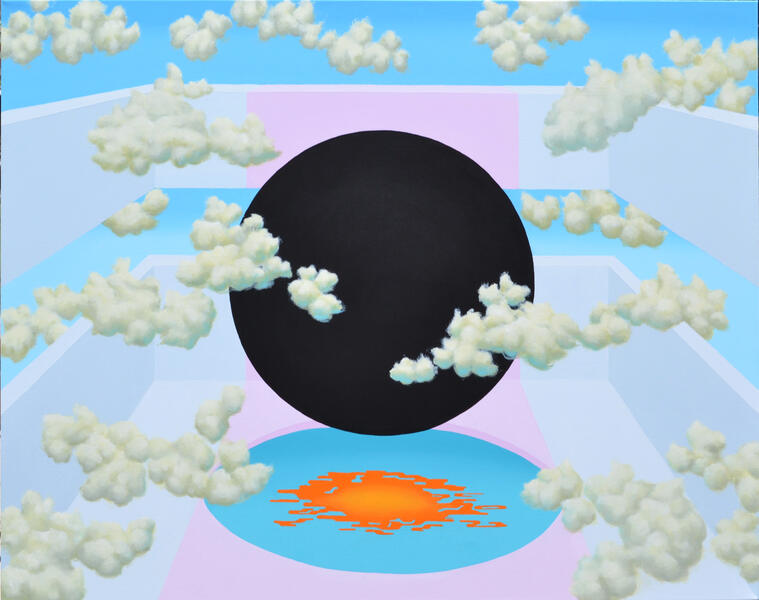 Total Eclipse RoomAcrylic on Canvas 32”x40” 2017
Total Eclipse RoomAcrylic on Canvas 32”x40” 2017 -
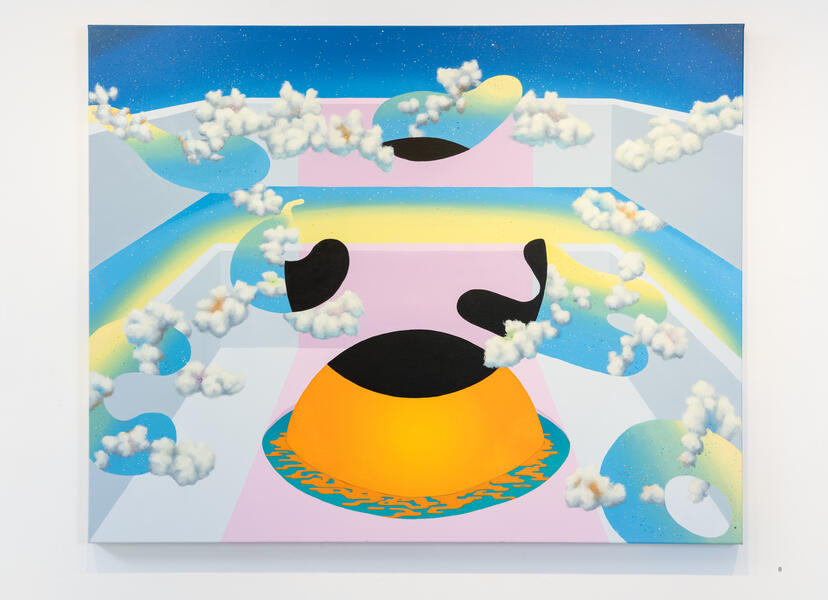 Total Eclipse Alternate RoomAcrylic on Canvas 32”x40” 2018
Total Eclipse Alternate RoomAcrylic on Canvas 32”x40” 2018 -
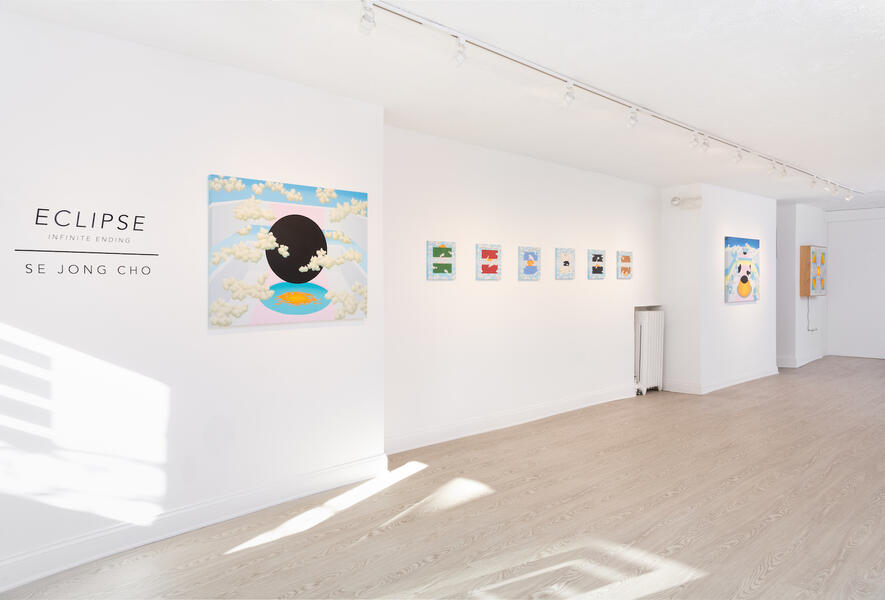 Catalyst installation3Installation view
Catalyst installation3Installation view -
 Blue Pin Cusion36”x26” Acrylic on Canvas 2020
Blue Pin Cusion36”x26” Acrylic on Canvas 2020
Extraction
[1] O’Keefe, Georgia. Letter to Maria Chabot, ‘In the Air’, November 1941, in Cowart, Hamilton and Greenough (eds.) 1987. P.231.
-
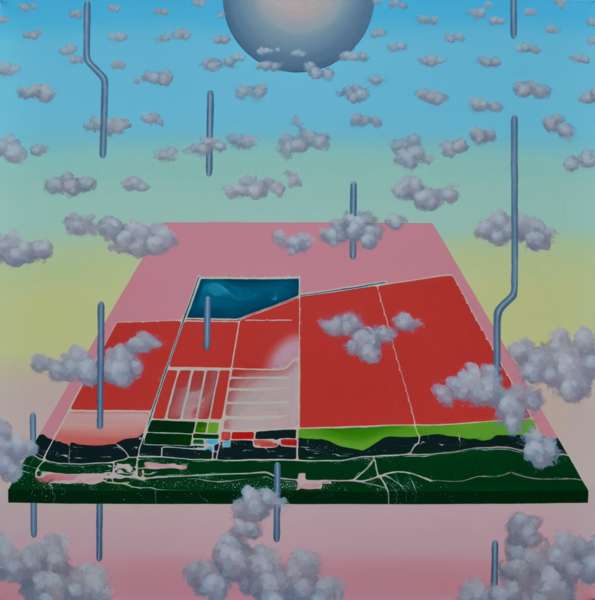 Hutt Lagoon: Algae Farm36”x36”, acrylic on canvas, 2019
Hutt Lagoon: Algae Farm36”x36”, acrylic on canvas, 2019 -
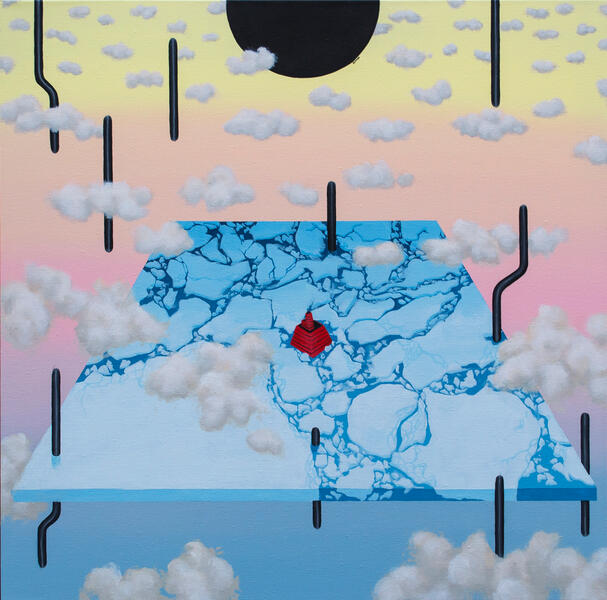 Arctic Oil Rig24”24”, acrylic on canvas, 2019
Arctic Oil Rig24”24”, acrylic on canvas, 2019 -
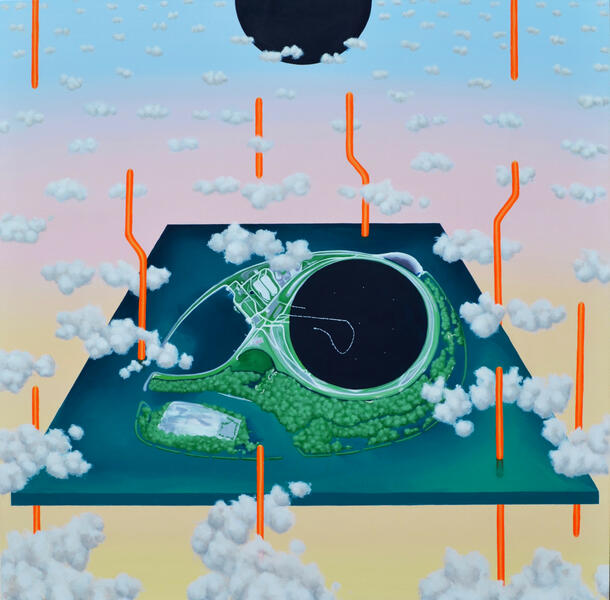 Ijsseloog: Waste IslandAcrylic on Canvas 36”x36” 2019
Ijsseloog: Waste IslandAcrylic on Canvas 36”x36” 2019 -
 Grande Dixence DamAcrylic on Canvas 36”x36” 2018
Grande Dixence DamAcrylic on Canvas 36”x36” 2018 -
 Lake Houses24”x24”, acrylic on canvas, 2019
Lake Houses24”x24”, acrylic on canvas, 2019 -
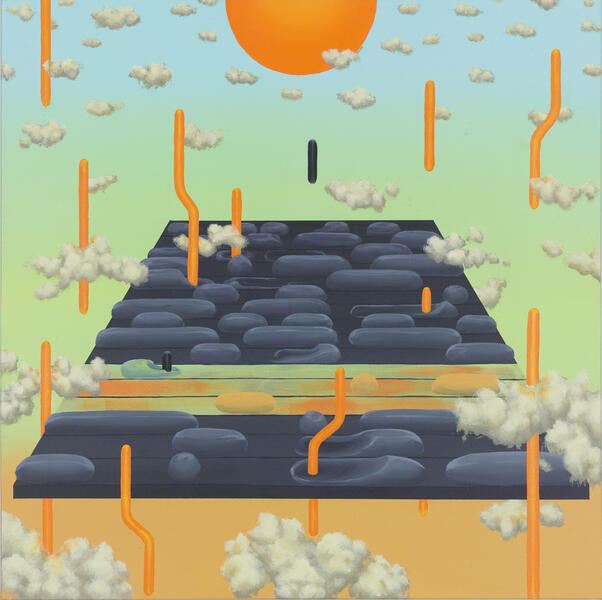 Coal Terminal24”x24”, acrylic on canvas, 2019
Coal Terminal24”x24”, acrylic on canvas, 2019 -
 Agricultural Landscape36”x36”, acrylic on canvas, 2021
Agricultural Landscape36”x36”, acrylic on canvas, 2021 -
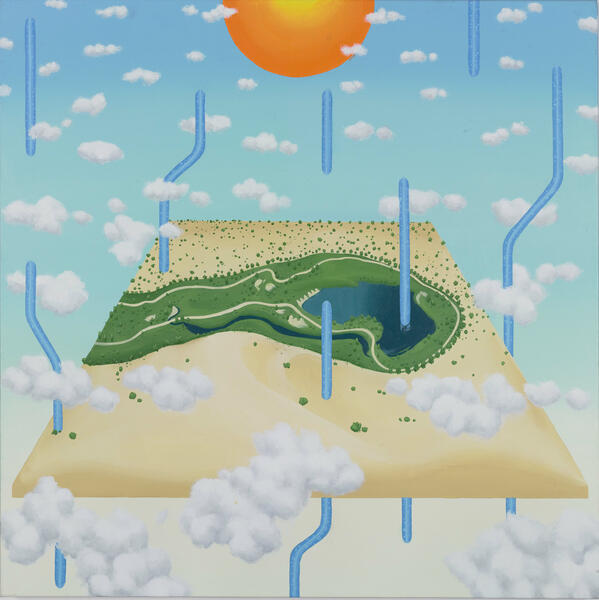 Desert Golf CourseAcrylic on Canvas 24”x24” 2019
Desert Golf CourseAcrylic on Canvas 24”x24” 2019 -
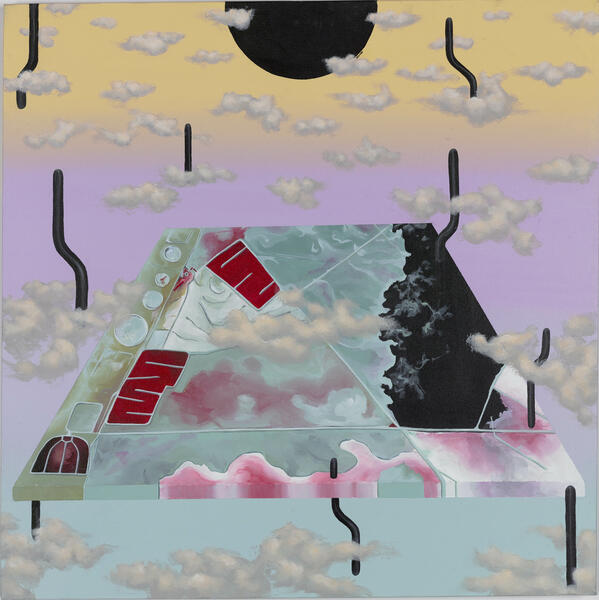 Potash PondAcrylic on Canvas 24”x24” 2017
Potash PondAcrylic on Canvas 24”x24” 2017
Matisse in bath
I first saw Matisse’s “Large Reclining Nude” at the Baltimore Museum of Art. Next to the painting, there is an explanatory plaque, showing how Matisse transitioned from precise depictions of the figure to more abstracted colors and shapes. It struck me that this generalization required rigor and imagination, and I decided to explore Mattisse’s paintings as a way to expand my understanding of creative expression.
Impressionists brought brilliant colors back to Western art after a period of realism, where light and shadow prevailed over color. Japanese ukiyo-e art prints influenced Impressionist painters, and this is evident not only in the colors, but also in the style and subject matter. Likewise, Matisse’s work is evocative of the flatness and colors of Japanese art, but also is reminiscent of decorative Islamic art, and sculptural African art. Through the synthesis of multiple cultures, Matisse created art works that tantalize and inspire so many people to this day.
My experiment in interpreting Matisse’ work is inspired by this possibility for synthesis across multiple ideologies and cultures. There is an advise from Cezanne to “deal with nature by means of the cylinder, the sphere, and the cone.” I approach painting with an appreciation for the complexities of our reality as a scientist, and I solve the challenge of representing this complexity. Einstein said, everything should be “made as simple as possible, but not simpler.” Painting Matisse interpretations presented me with the challenge of painting full continuous figures, which I had never done, and I approached this challenge by meeting a compromise between Matisse’ beautiful generalization of figure and my proclivity toward precision. I wanted these paintings to echo Matisse’s shapes and colors, but also create something new by merging my identity as an Asian woman and a scientist with Matisse’s.
Problems with nudes
Nudes are problematic and I was hesitant to create images that reinforce the particular existence of women that has been prevalent in the usage and conventions of Western art. From Berger’s Ways of Seeing: “To be born a woman has been to be born…into keeping of men… A woman must continually watch herself. She is almost continually accompanied by her own image of herself. Whilst she is walking across a room or whilst she is weeping at the death of her father, she can scarcely avoid envisaging herself walking or weeping.” In other words, women are less present than seen. Take Matisse’ reclining nude, for example; it’s a picture of a naked woman who is posing because she is aware of the surveyors’ gaze, including Matisse’s. So, I was conflicted about creating female nudes as objects to be seen. Painting these nudes, however, forced me to think about the implications of male gaze in women’s lives and how to resolve them in my own work.
How do I preclude the male gaze in female nude paintings? I concluded that if the figures are present, and are comfortable with their presences, then they are not merely posing to be seen; rather, they are daring to take up space in the world.
Traditional female nudes are often supine as if they lack strong spine to stand by herself. You take away the spine; women nevertheless survive, maybe with new found strength. In these paintings, the figures are quite spineless, but this spinelessness allows for certain vitality, with figures lunging, sliding, and jumping. The absence of features and orifices came about as a whim, but this strategy allowed me to avoid assigning individuality to these figures. In fact, they are not individuals; they are not even humans. They are derivatives of me, and all the things I have seen in my life with my female eyes.
These nudes were also fun to paint. Georgia O’Keefe never meant to paint human vulvae with her flowers, and insisted that her skulls were not meant to convey death; they were simply “nice things” to paint. I approached these nudes the same way. The nudes were fun to paint with all the complexity of bones and muscles hidden under the layer of skin.
-
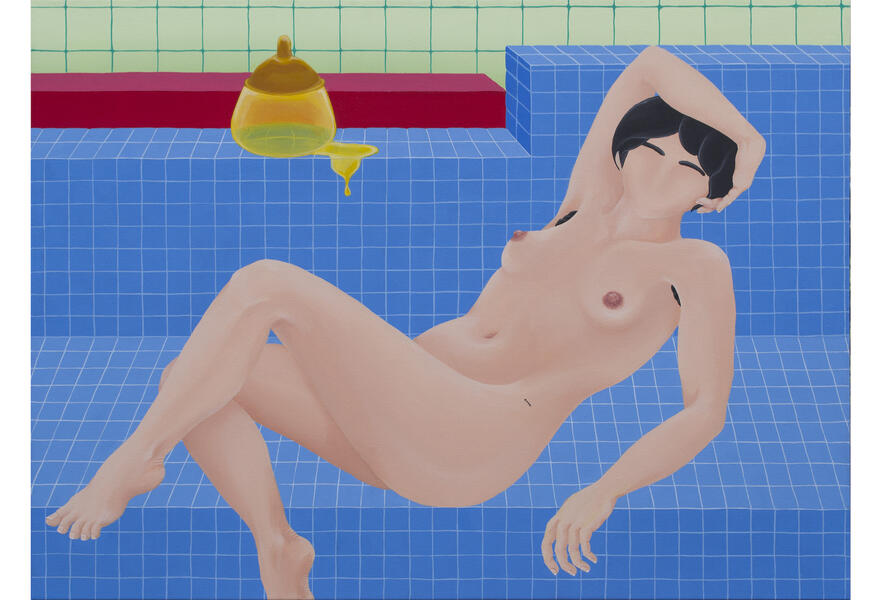 large Reclining NudeLarge reclining nude (2017) 30”x40” Acrylic on canvas
large Reclining NudeLarge reclining nude (2017) 30”x40” Acrylic on canvas -
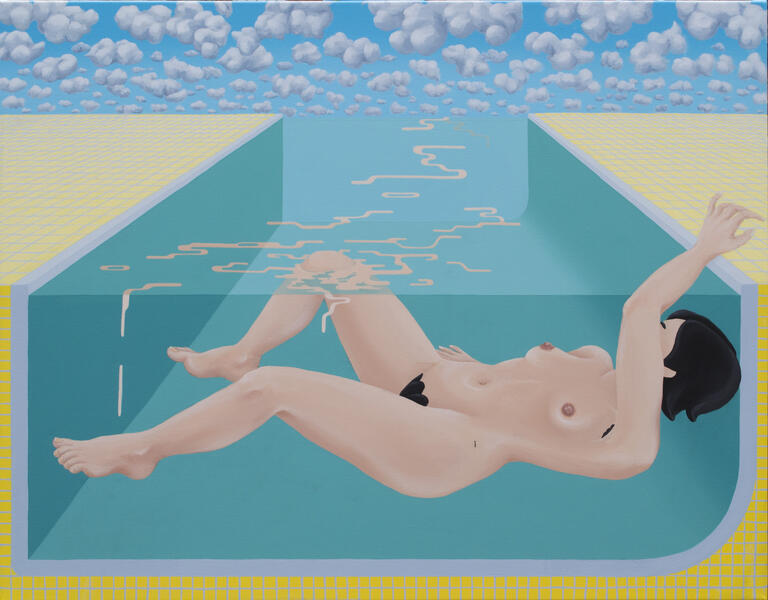 Nude with WavesNude with waves (2018) 30”x40” Acrylic on canvas
Nude with WavesNude with waves (2018) 30”x40” Acrylic on canvas -
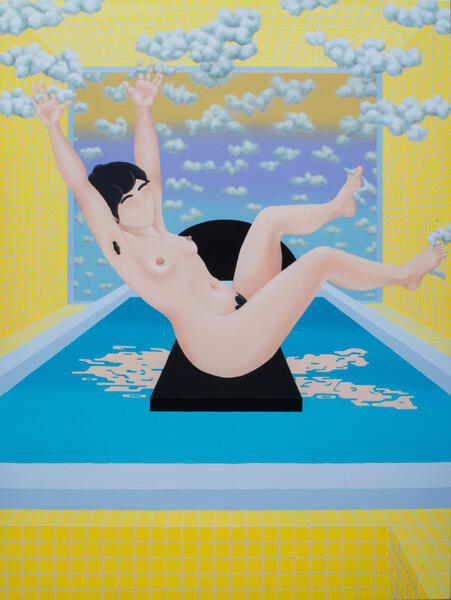 TobagonTobagon (2018) 48”x36” Acrylic on canvas
TobagonTobagon (2018) 48”x36” Acrylic on canvas -
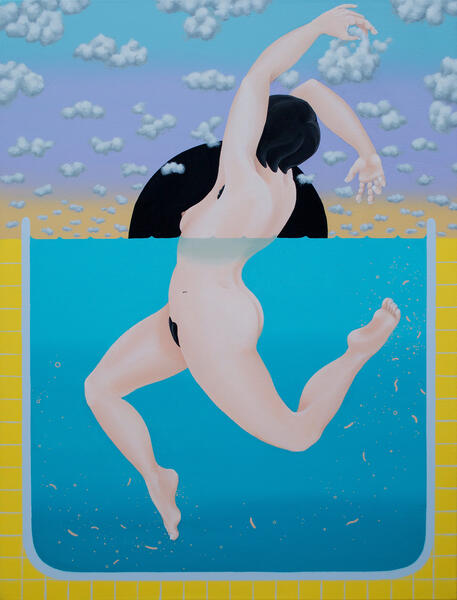 Nude with Hair in the WindNude with hair in the air (2018) 48”x36” Acrylic on canvas
Nude with Hair in the WindNude with hair in the air (2018) 48”x36” Acrylic on canvas -
 Current Gallery InstallationInstallation view
Current Gallery InstallationInstallation view
in/outside of room/f
My house will have a roof.
-Paul Eluard, Dignes de vivre, Julliard, Paris, p. 115
You can read a room, or you can read a house. Both are psychological diagram that guide artists in their analysis of intimacy[1].
The artist used the rooms and roofs as a context for her to explore intuition. The placements of the objects inside of a room or outside on a roof are arbitrary with no symbolic gestures. Jung, in “depths of the unknown:” intuition is our interface with the whole of our potential.2 She used intuition to achieve harmoniousness, using whatever ability she has, in the spaces portrayed. The result is a certain style: a precise depiction of objects using controlled color selection. Cocteau writes: “Style is the soul, and unfortunately with us the soul assumes the form of the body” in refuting the decorative encumbrance any work of art with style may face. These paintings are things depicted through a certain style that should be experienced, because there is no content in these paintings, but hopefully they will excite or captivate the audience. This is the most intimate way the artist can connect with the audience.
[1] Bachelard, G., Stilgoe, J.R., 1994. The Poetics of Space, Reprint edition. ed. Beacon Press, Boston.
-
 Roof with Waterfall20"x16" acrylic on canvas 2017
Roof with Waterfall20"x16" acrylic on canvas 2017 -
 Roof with Pool20"x16" acrylic on canvas 2016
Roof with Pool20"x16" acrylic on canvas 2016 -
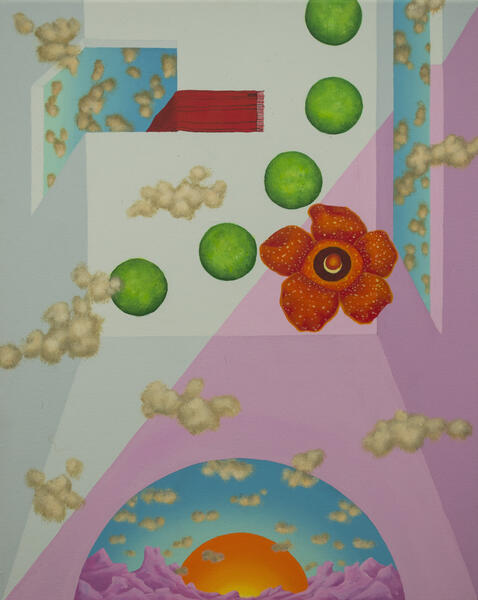 Roof with Flower20"x16" acrylic on canvas 2017
Roof with Flower20"x16" acrylic on canvas 2017 -
 Roof with Chairs20"x16" acrylic on canvas 2016
Roof with Chairs20"x16" acrylic on canvas 2016 -
 Roof with Watermelons20"x16" acrylic on canvas 2016
Roof with Watermelons20"x16" acrylic on canvas 2016 -
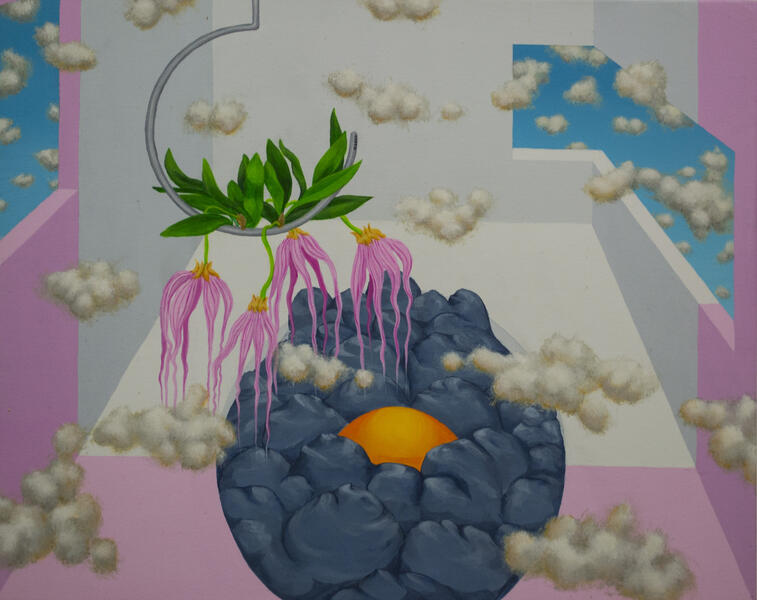 Room with Sun20"x16" acrylic on canvas 2017
Room with Sun20"x16" acrylic on canvas 2017 -
 Room with Pool20"x16" acrylic on canvas 2016
Room with Pool20"x16" acrylic on canvas 2016 -
 Room with Marbles20"x16" acrylic on canvas 2017
Room with Marbles20"x16" acrylic on canvas 2017 -
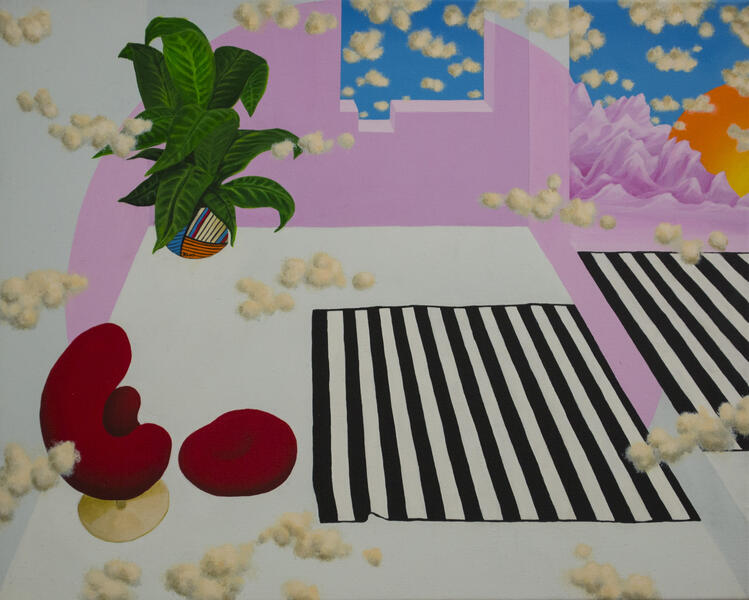 Room with View20"x16" acrylic on canvas 2016
Room with View20"x16" acrylic on canvas 2016 -
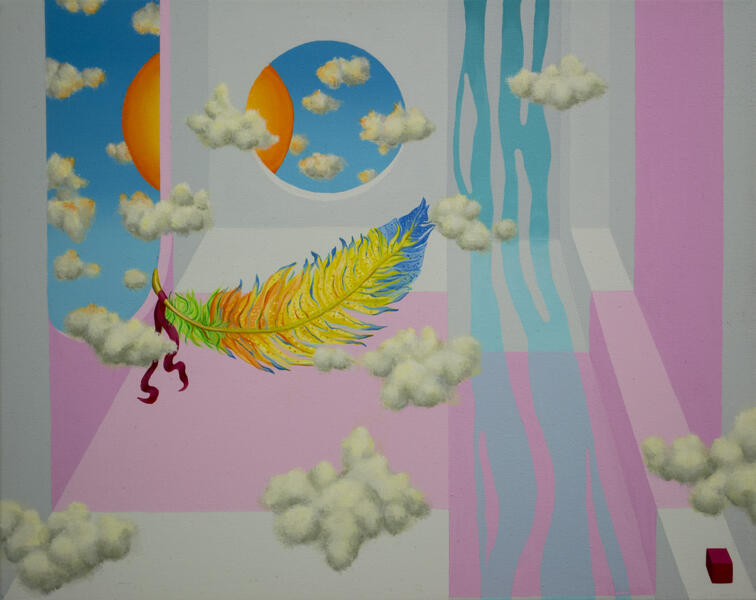 Room with Feather20"x16" acrylic on canvas 2017
Room with Feather20"x16" acrylic on canvas 2017
Evaporative images
“Art is the game of extending our ‘shape of real’ without the necessity of present practical affirmation.”[1]
Paintings are static but musical composition (not on paper but in the air) is dynamic. Therefore, while the representations of the clouds are static, we invite the audience to imagine the dynamic and constant transformation of clouds as the sound atmospherically evolves around them. The dual installation of sound and images is intended to involve audience in multiple modes of participation, stimulating both visual and auditory senses thereby creating an environment where emersion is possible. Rather than the audience merely looking into pictorial boxes as an external examiner, we invite the audience to experience the visual images as a context for extending the shape of real through synthesis of their memories of shapes of real.
[1] Irwin, R. Notes toward a Conditional Art. (J. Paul Getty Museum, 2011).
-
 Diamond horizon: pink in oragneAcrylic on canvas 24inx24in May 25, 2015
Diamond horizon: pink in oragneAcrylic on canvas 24inx24in May 25, 2015 -
 Diamond Horizon: orange in pinkAcrylic on canvas 24inx24in May 25, 2015
Diamond Horizon: orange in pinkAcrylic on canvas 24inx24in May 25, 2015 -
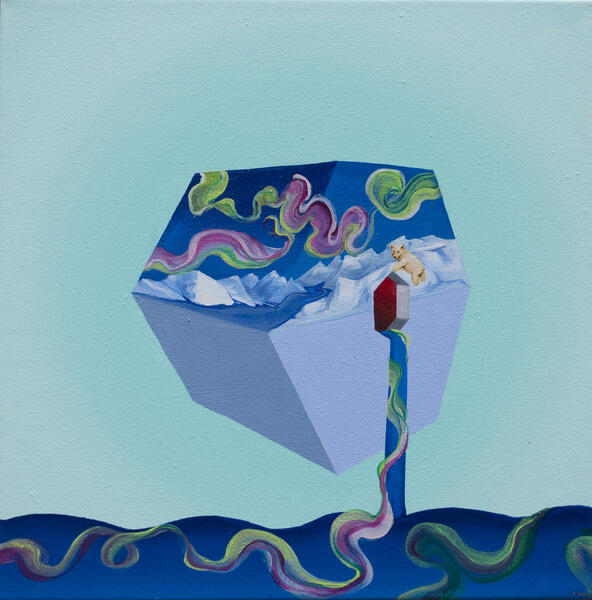 Glacier with a polar bear12 in x12 in Acrylic on canvas August 12, 2015
Glacier with a polar bear12 in x12 in Acrylic on canvas August 12, 2015 -
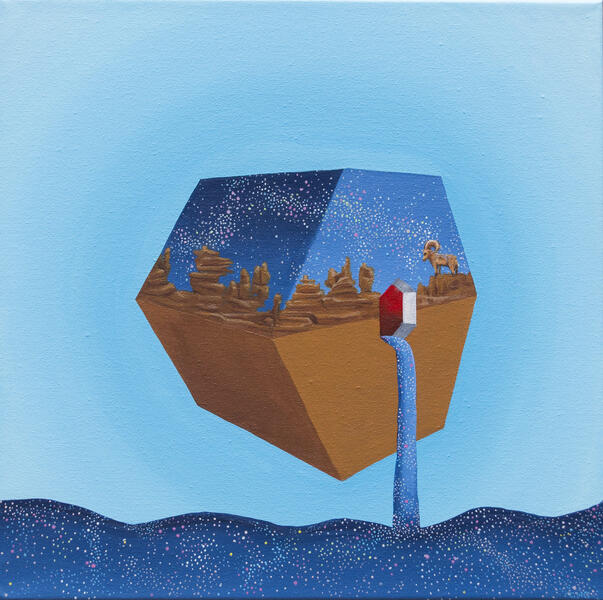 Bryce canyon with a mountain goat12in x12 in Acrylic on canvas August 12, 2015
Bryce canyon with a mountain goat12in x12 in Acrylic on canvas August 12, 2015 -
 Stellar CirculationAcrylic on canvas 36"x50" 2016
Stellar CirculationAcrylic on canvas 36"x50" 2016 -
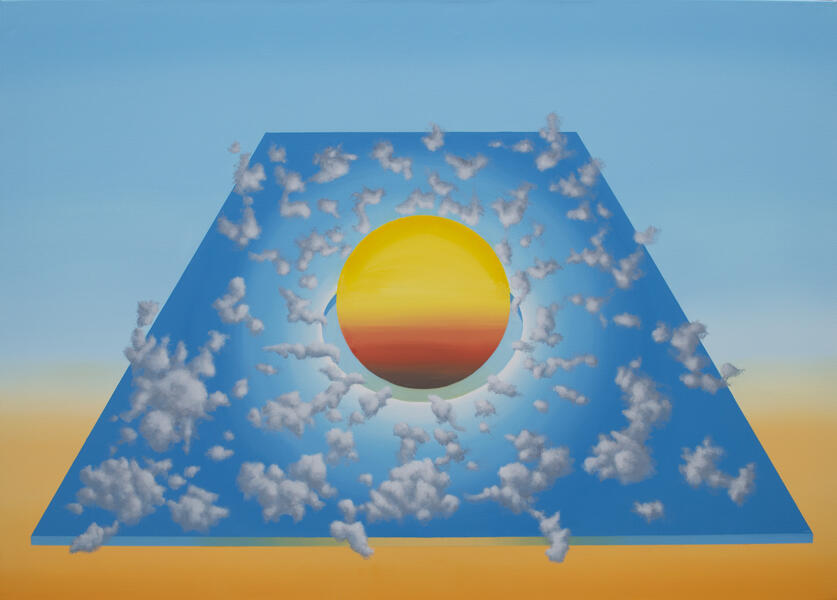 Cumulus SinkAcrylic on canvas 30"x40" 2016
Cumulus SinkAcrylic on canvas 30"x40" 2016 -
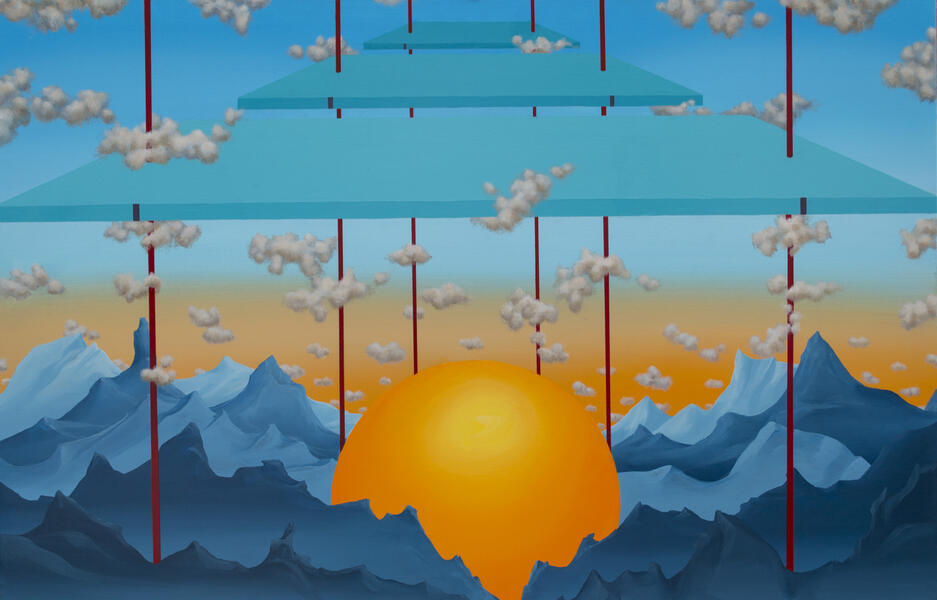 Sun SuspensionAcrylic on canvas 30"x40" 2016
Sun SuspensionAcrylic on canvas 30"x40" 2016 -
 River Deltas36”x72” acrylic on canvas 2014
River Deltas36”x72” acrylic on canvas 2014 -
 sunset simulationAcrylic on canvas 24"x24" 2015
sunset simulationAcrylic on canvas 24"x24" 2015 -
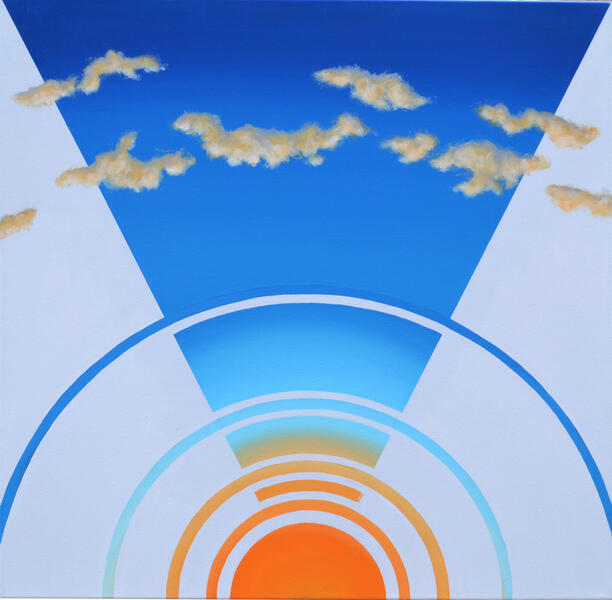 Sunrise SimulationAcrylic on canvas 24"x24" 2015
Sunrise SimulationAcrylic on canvas 24"x24" 2015

